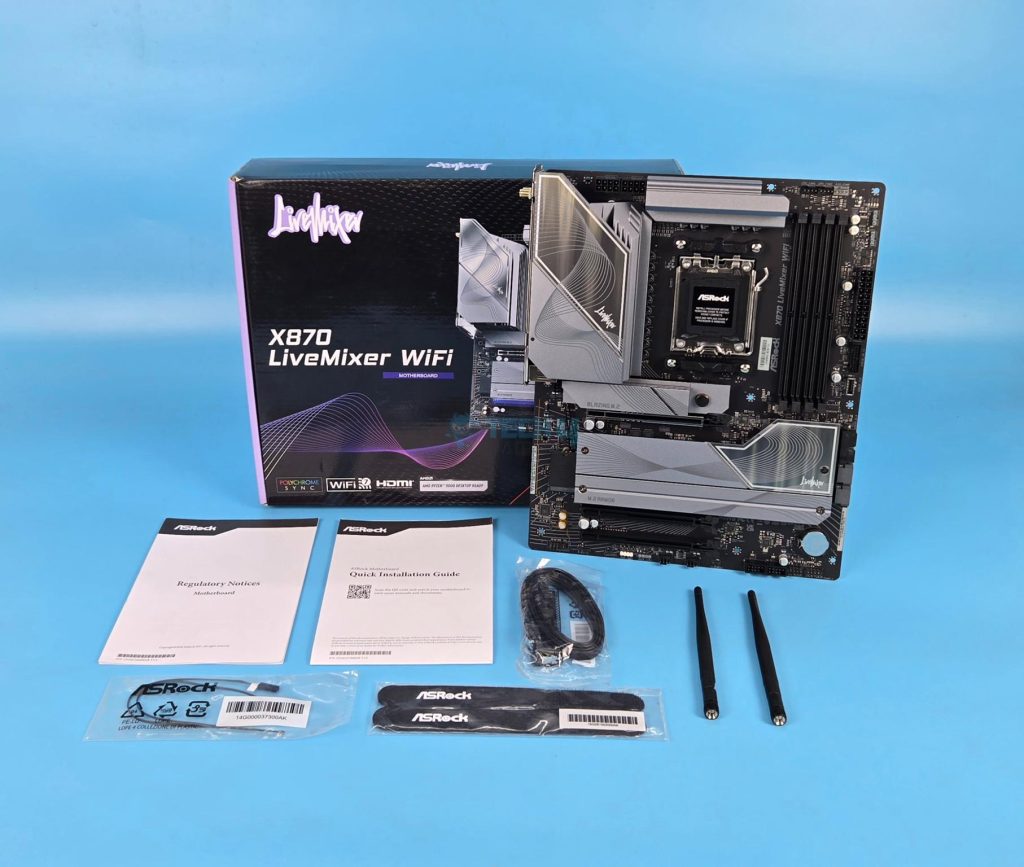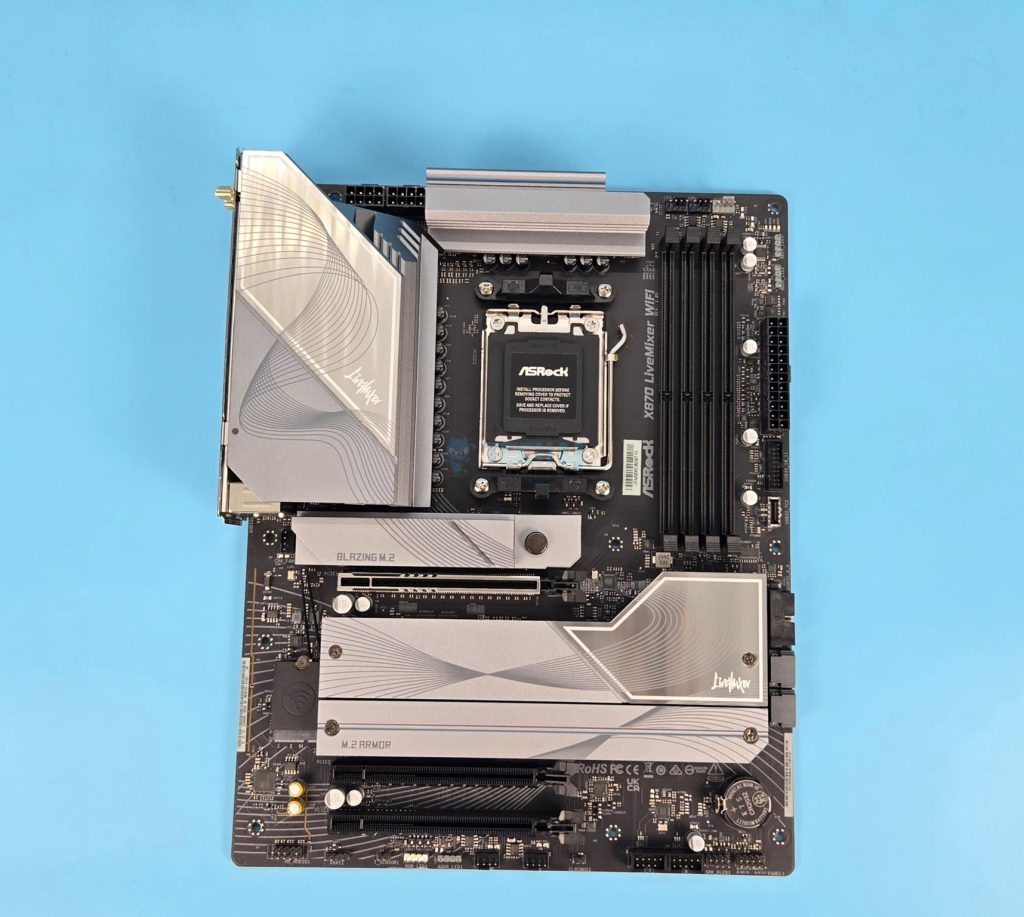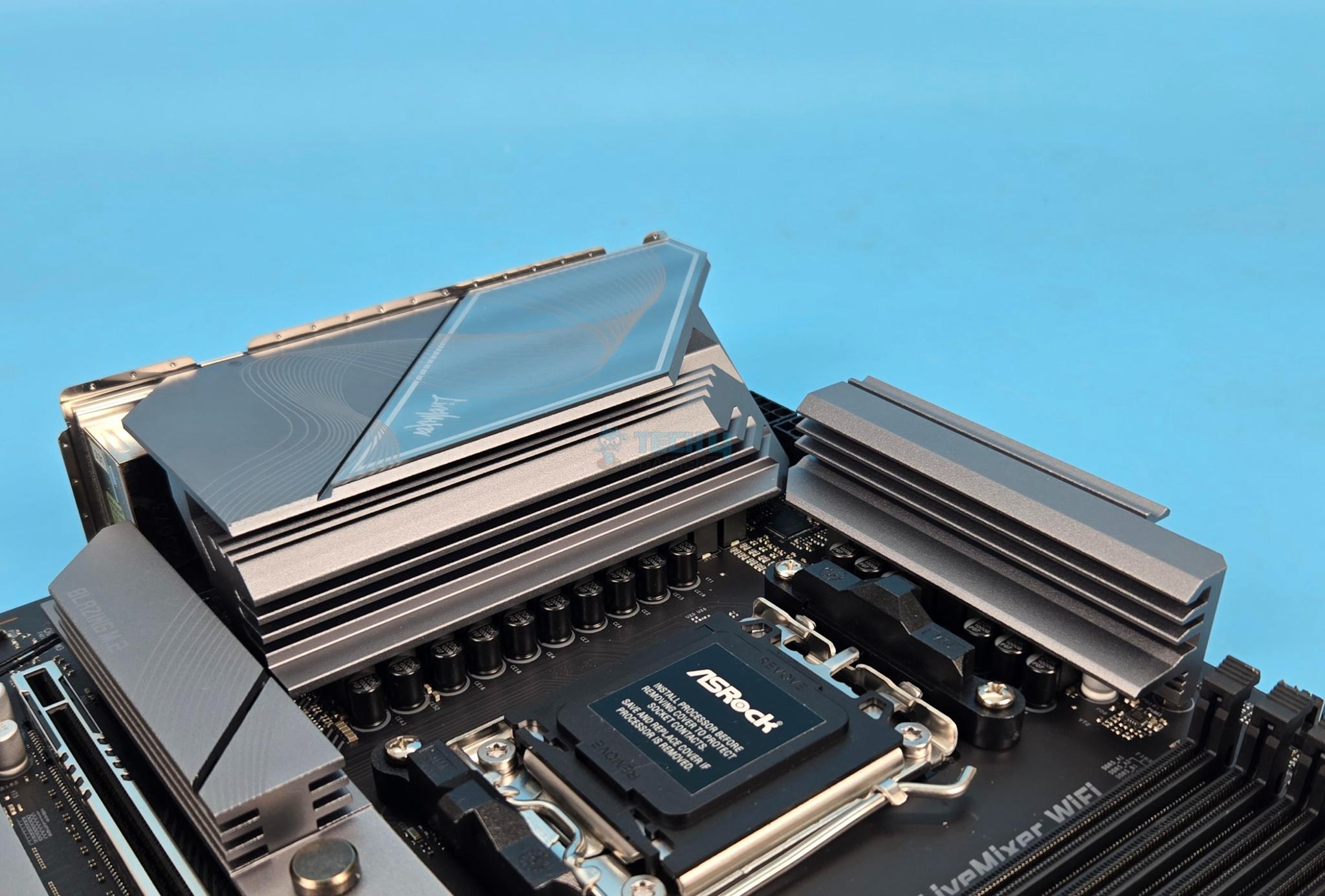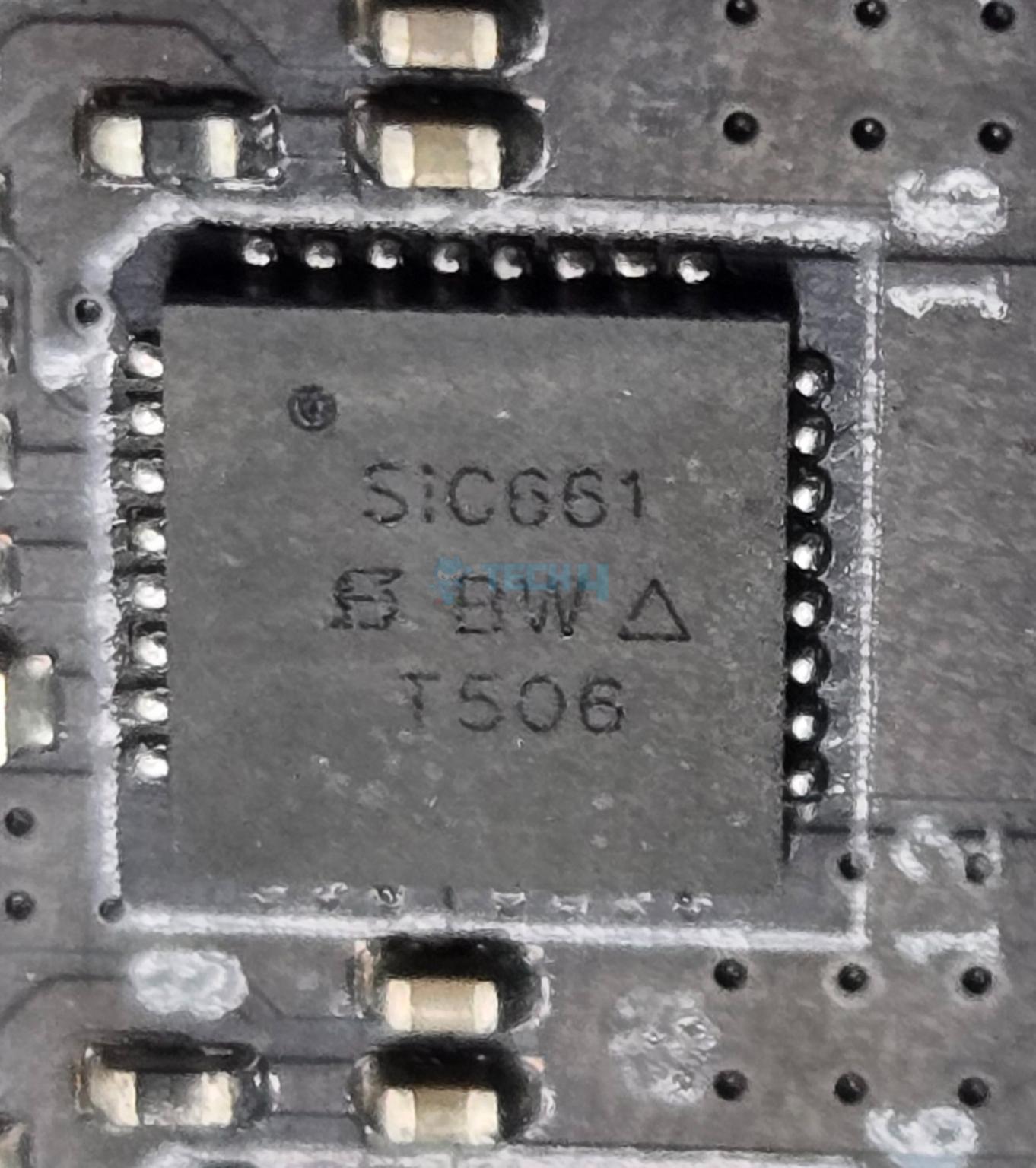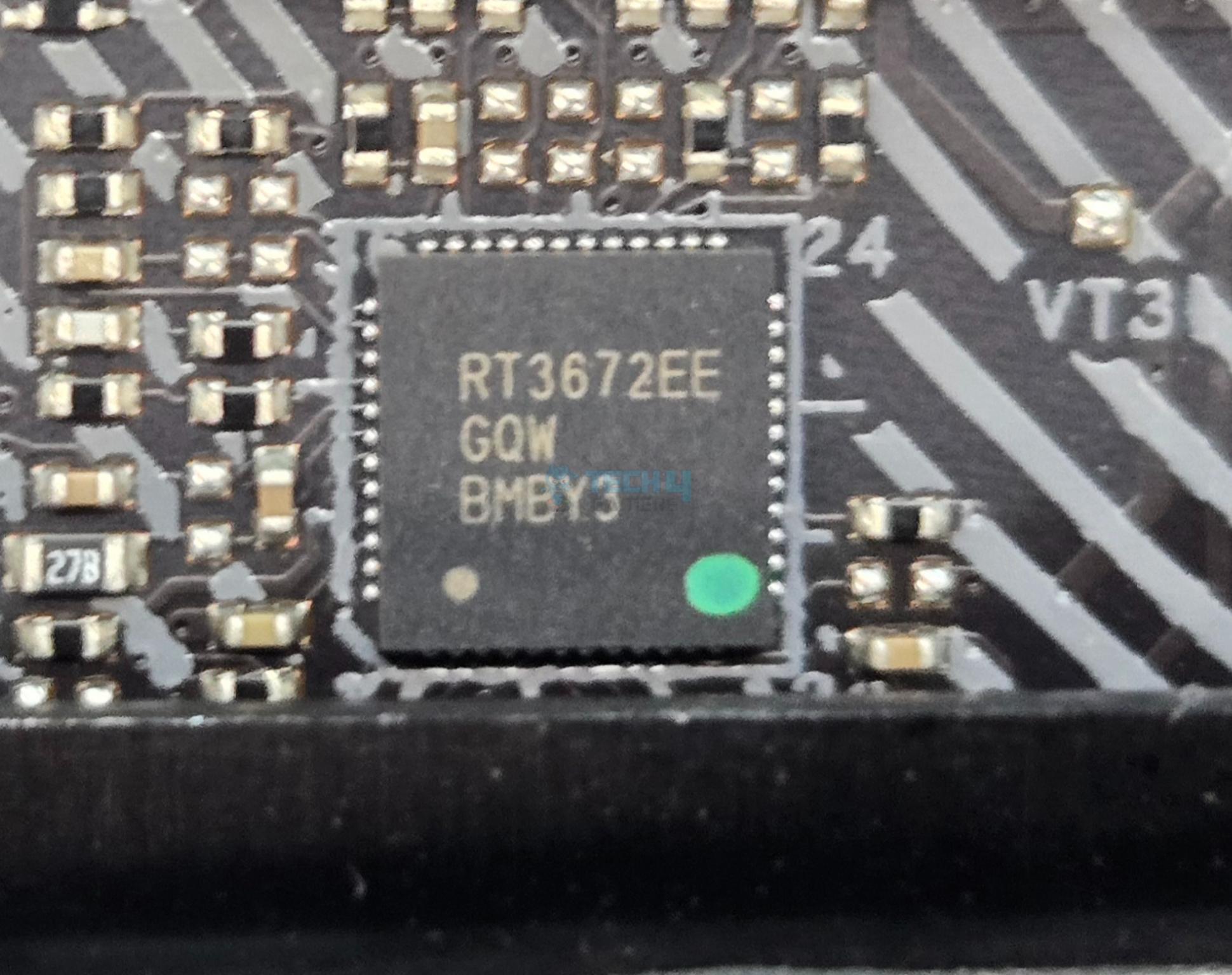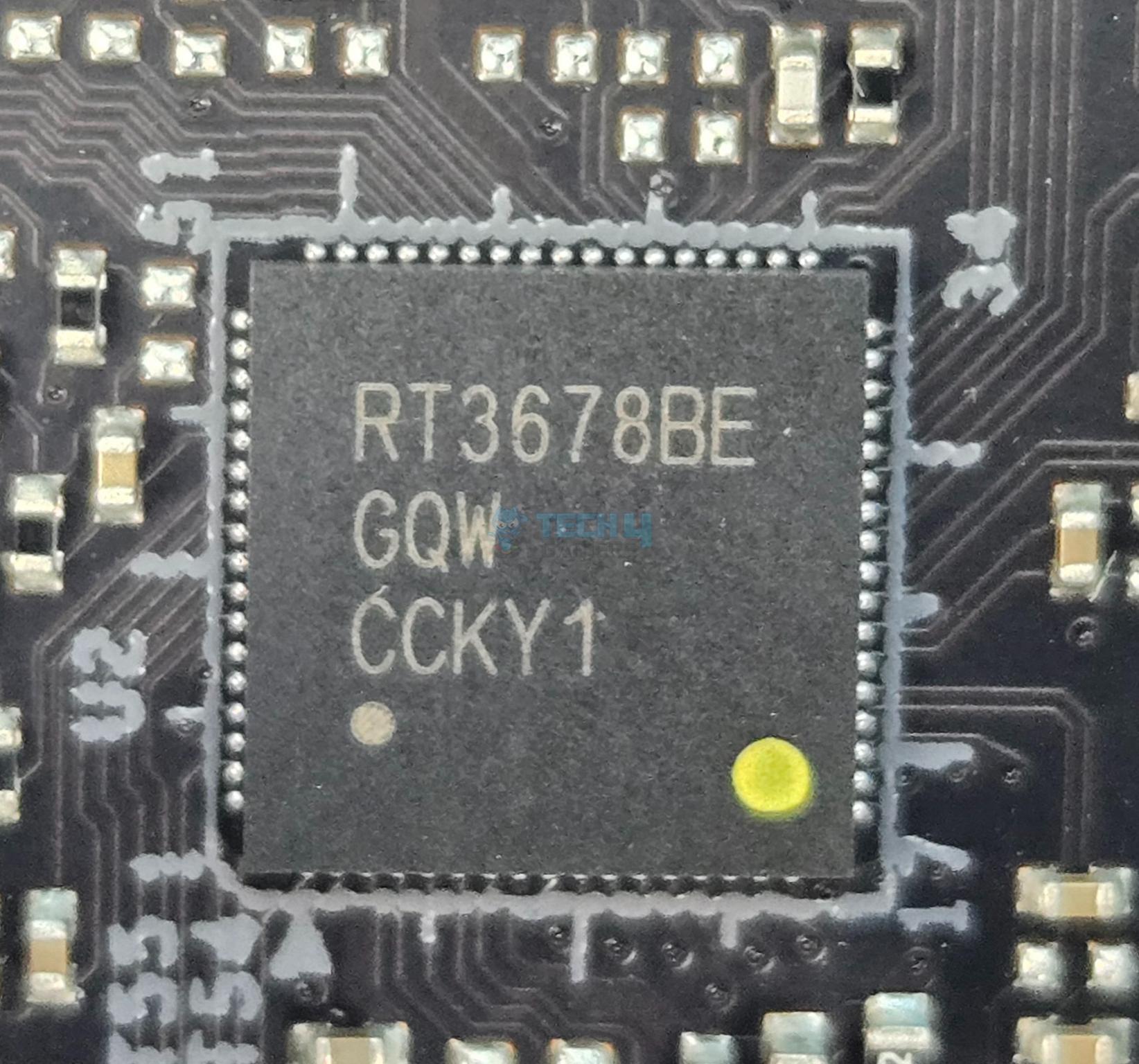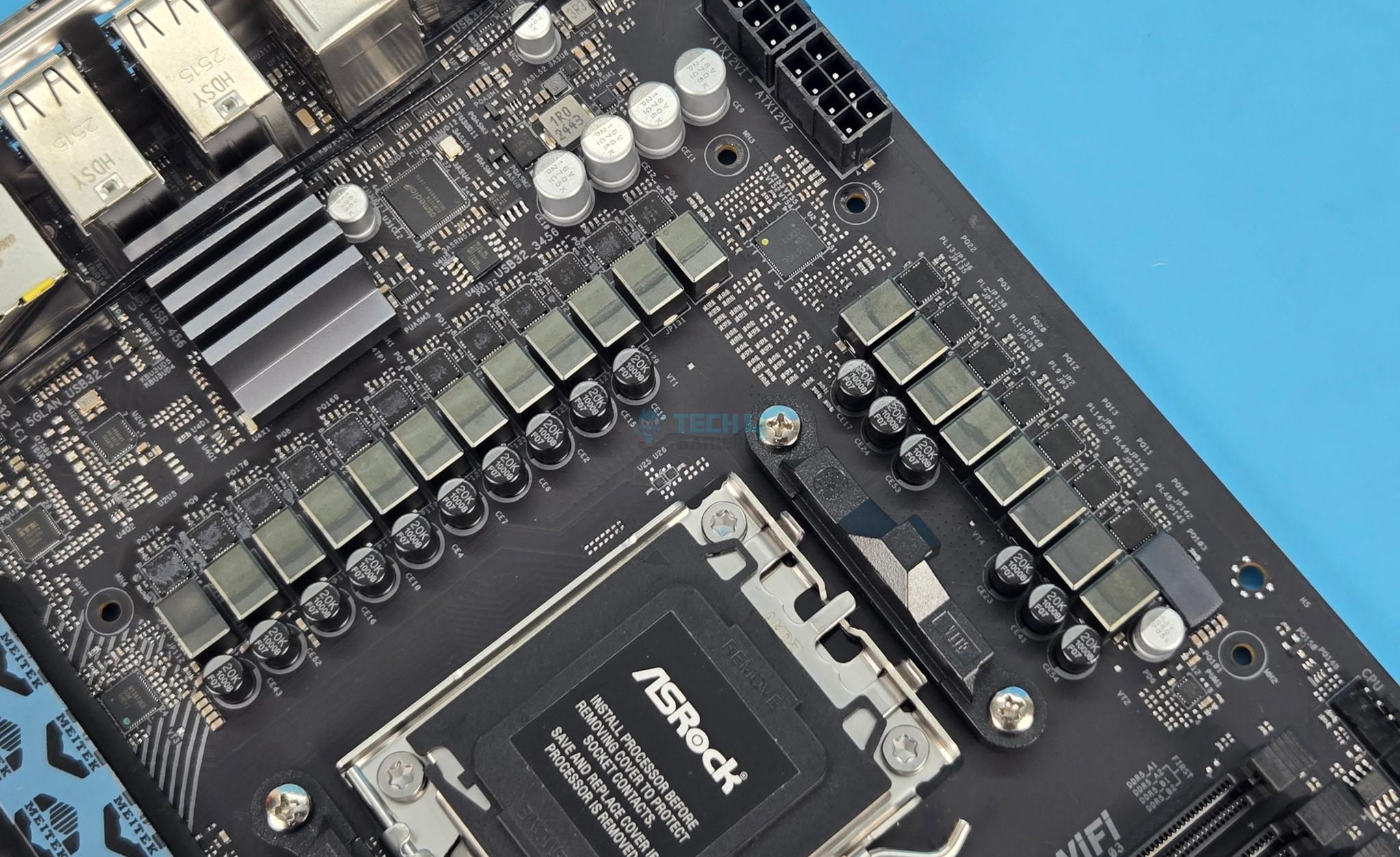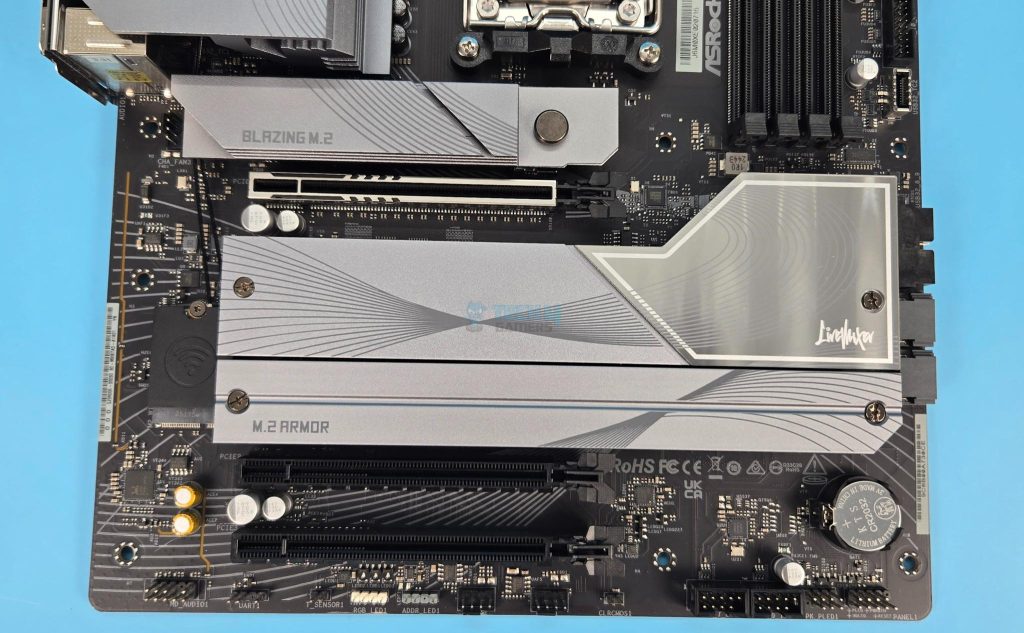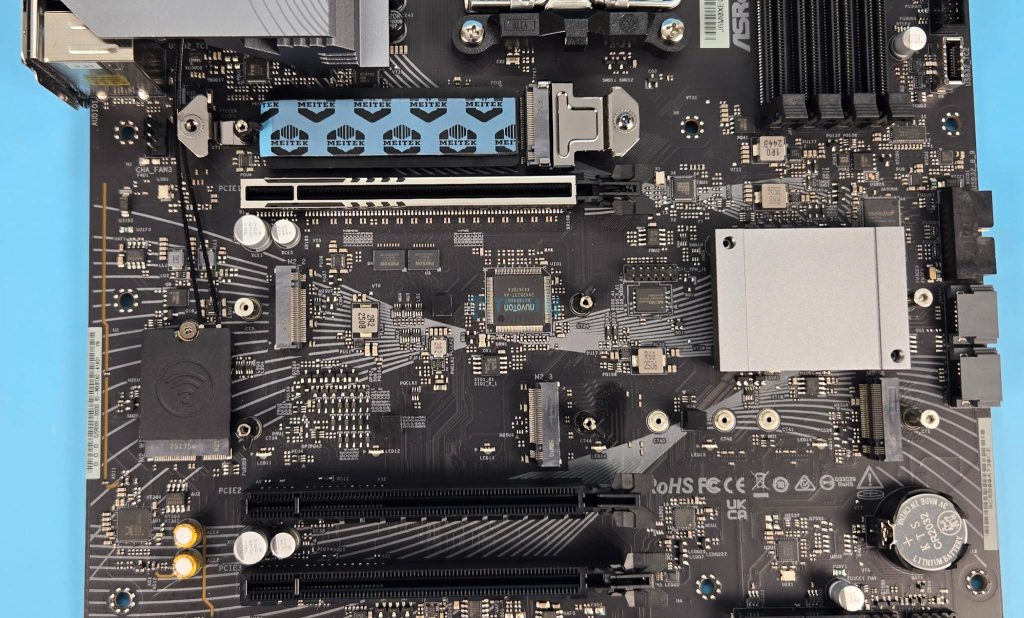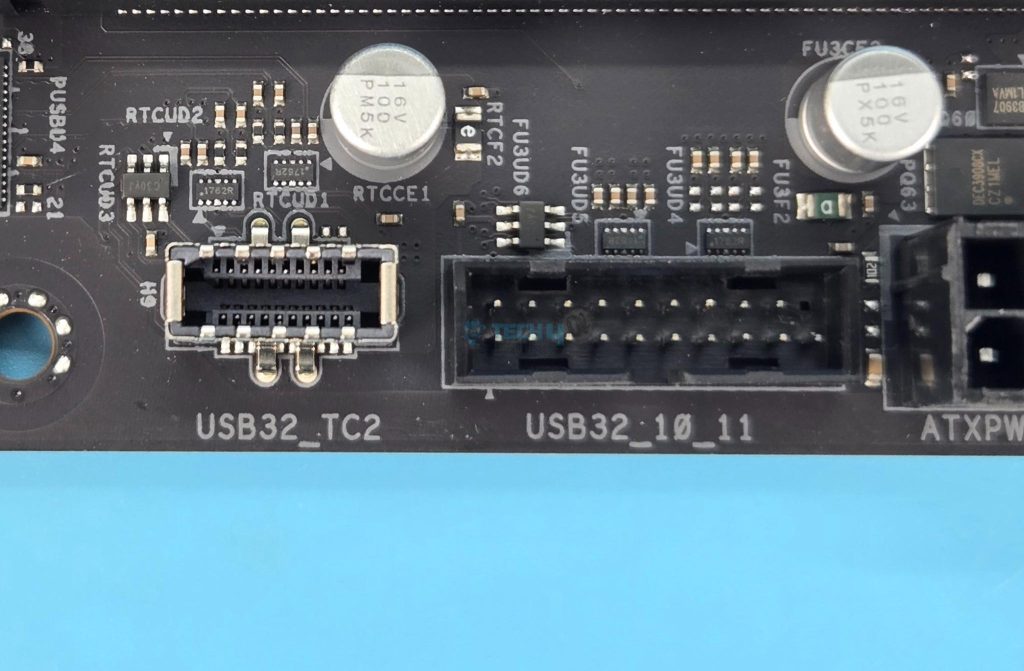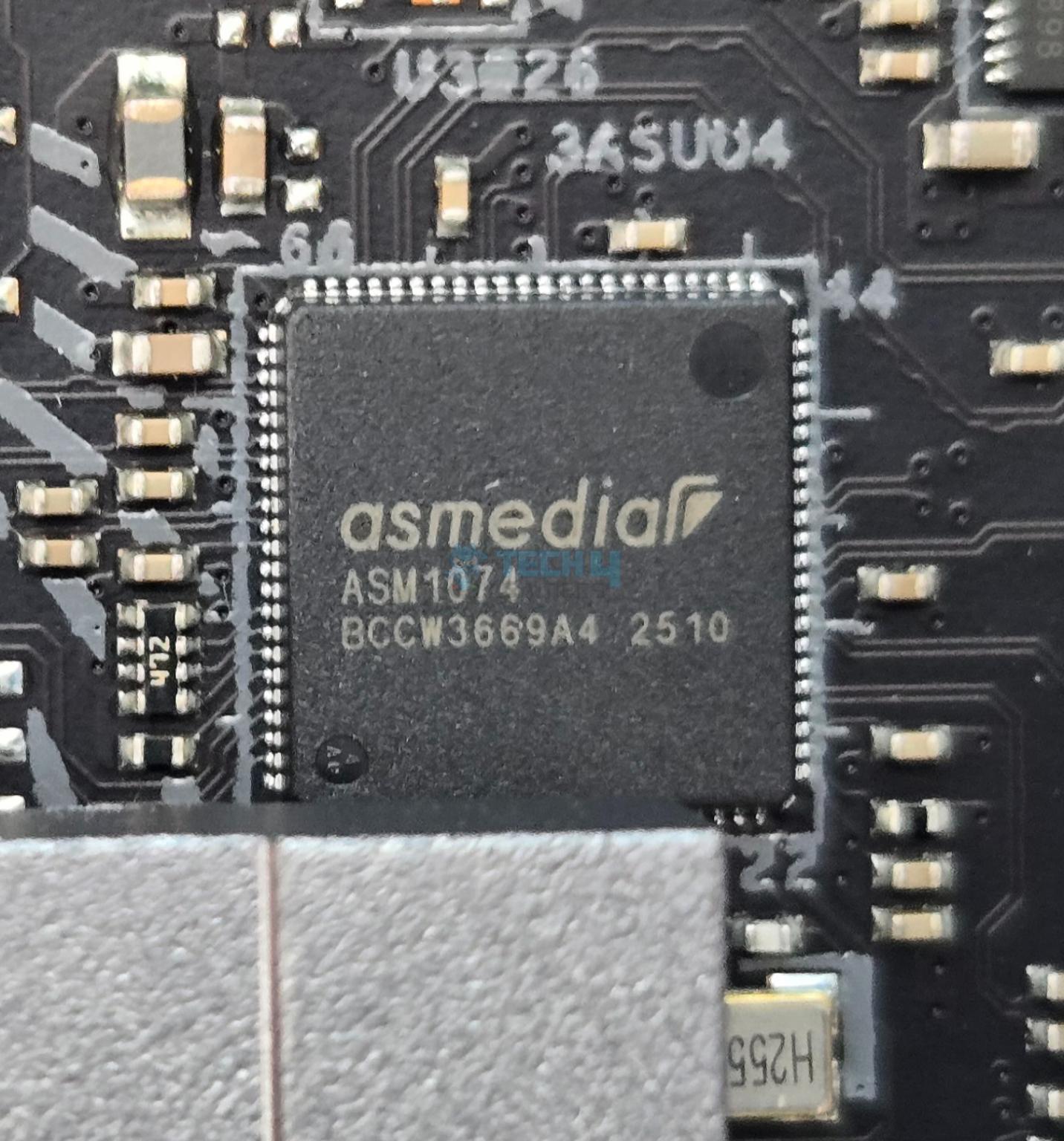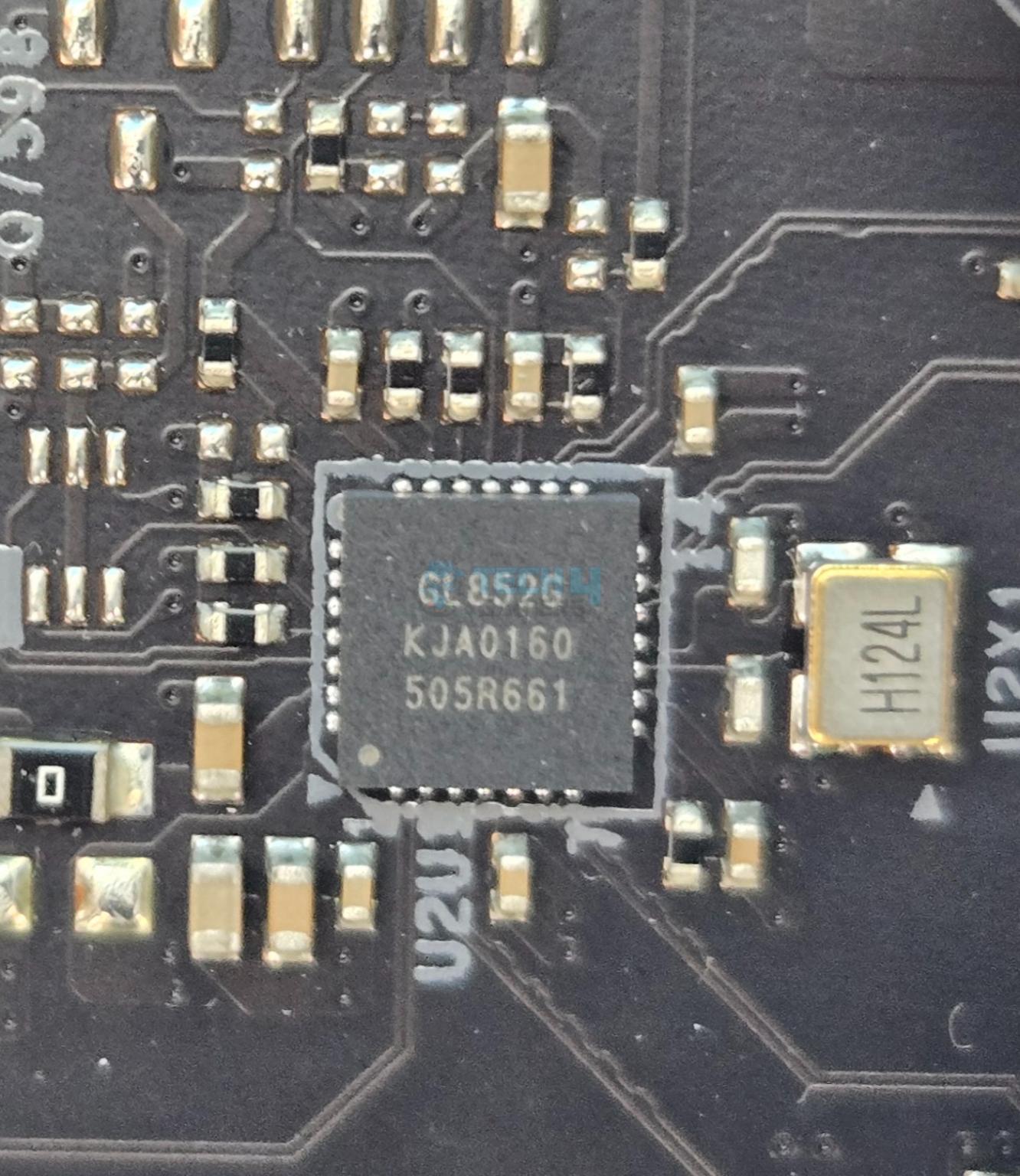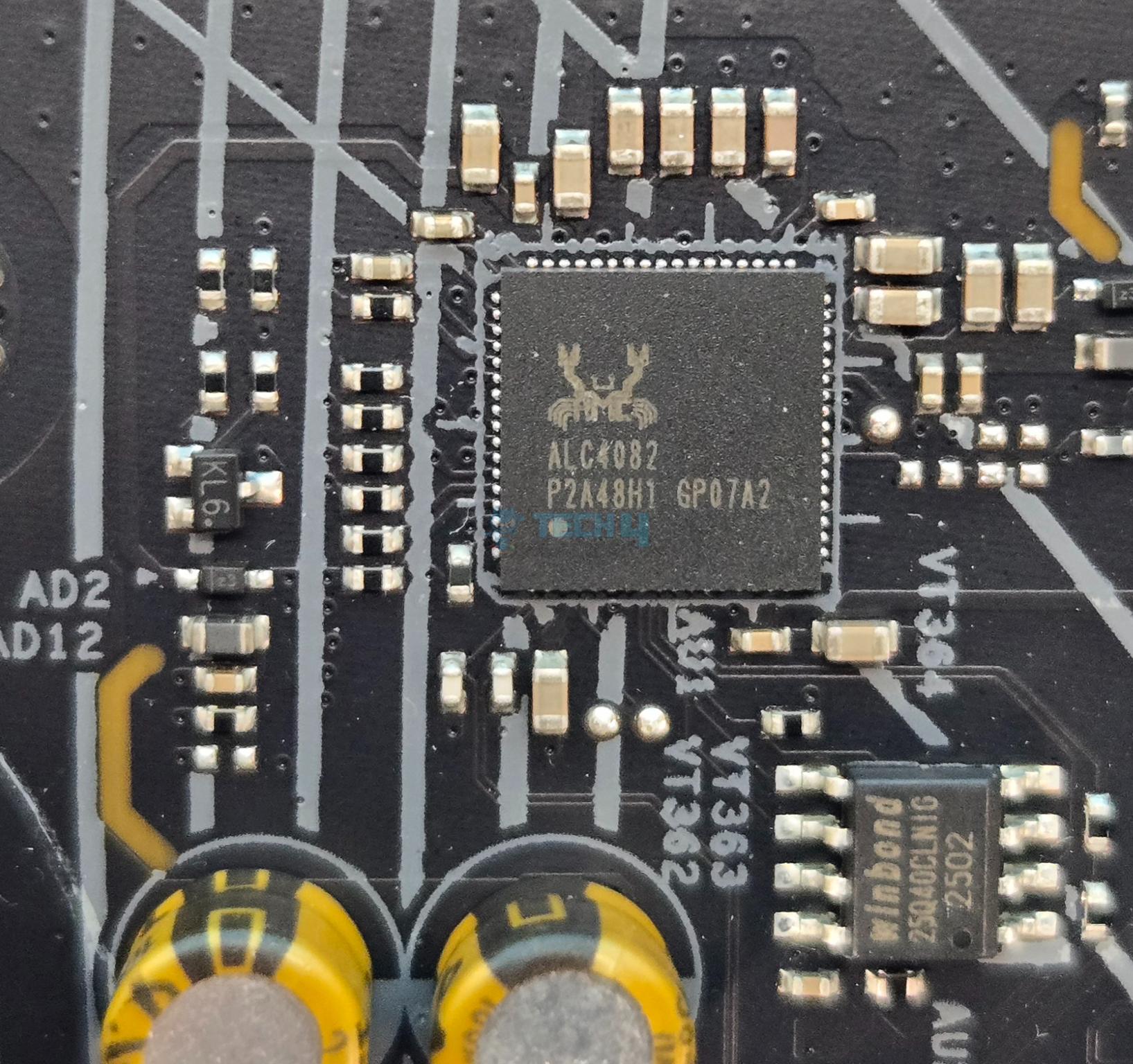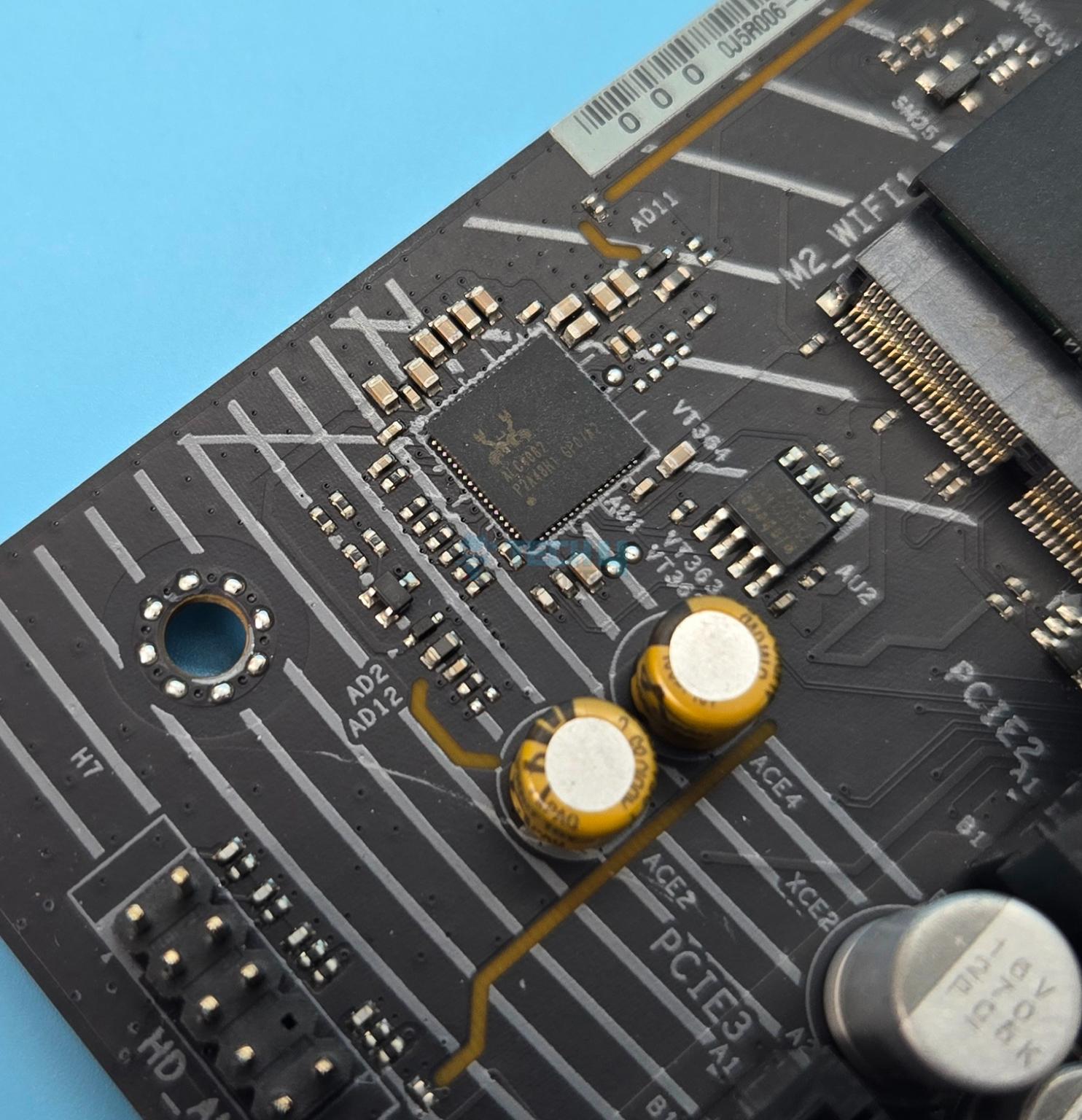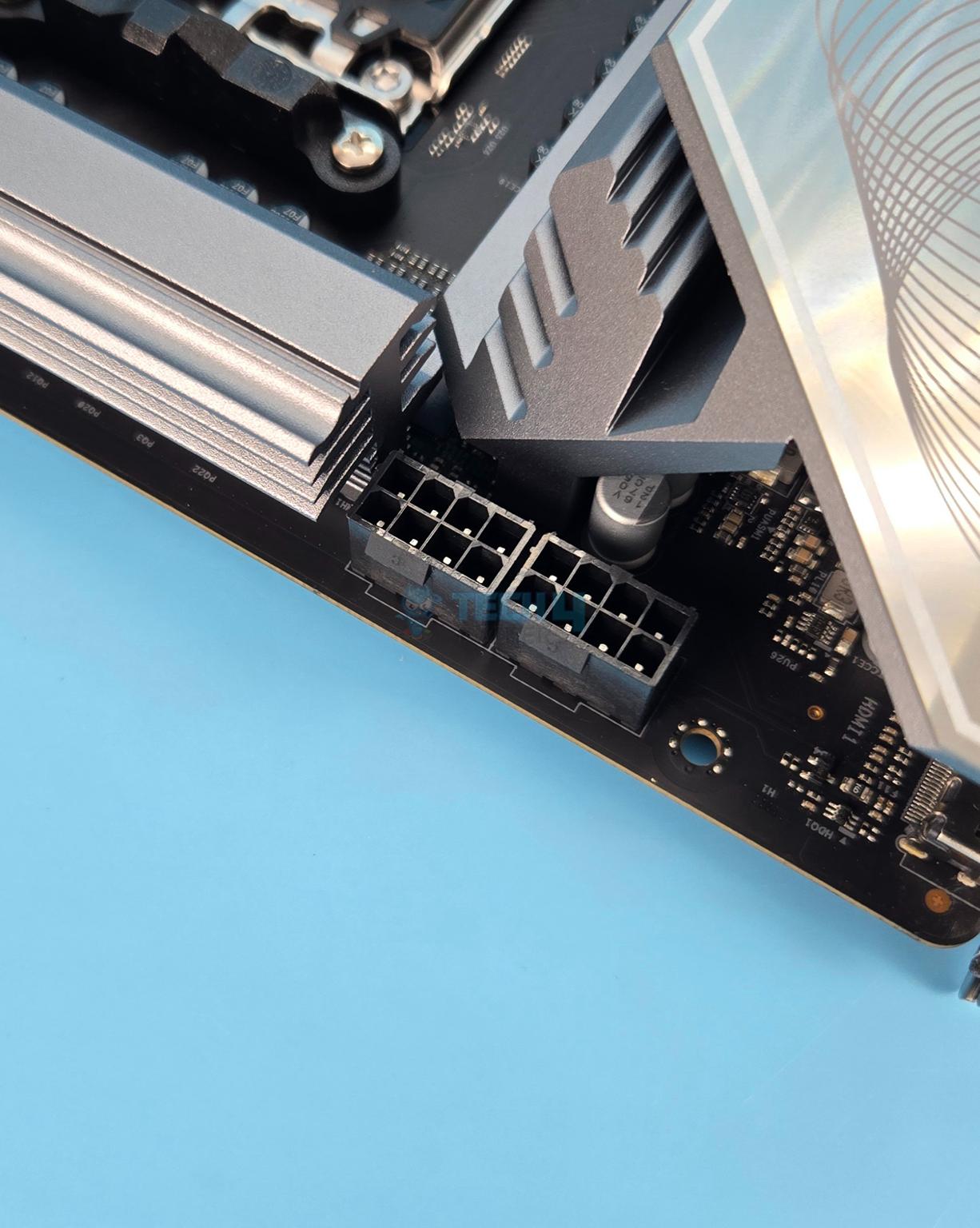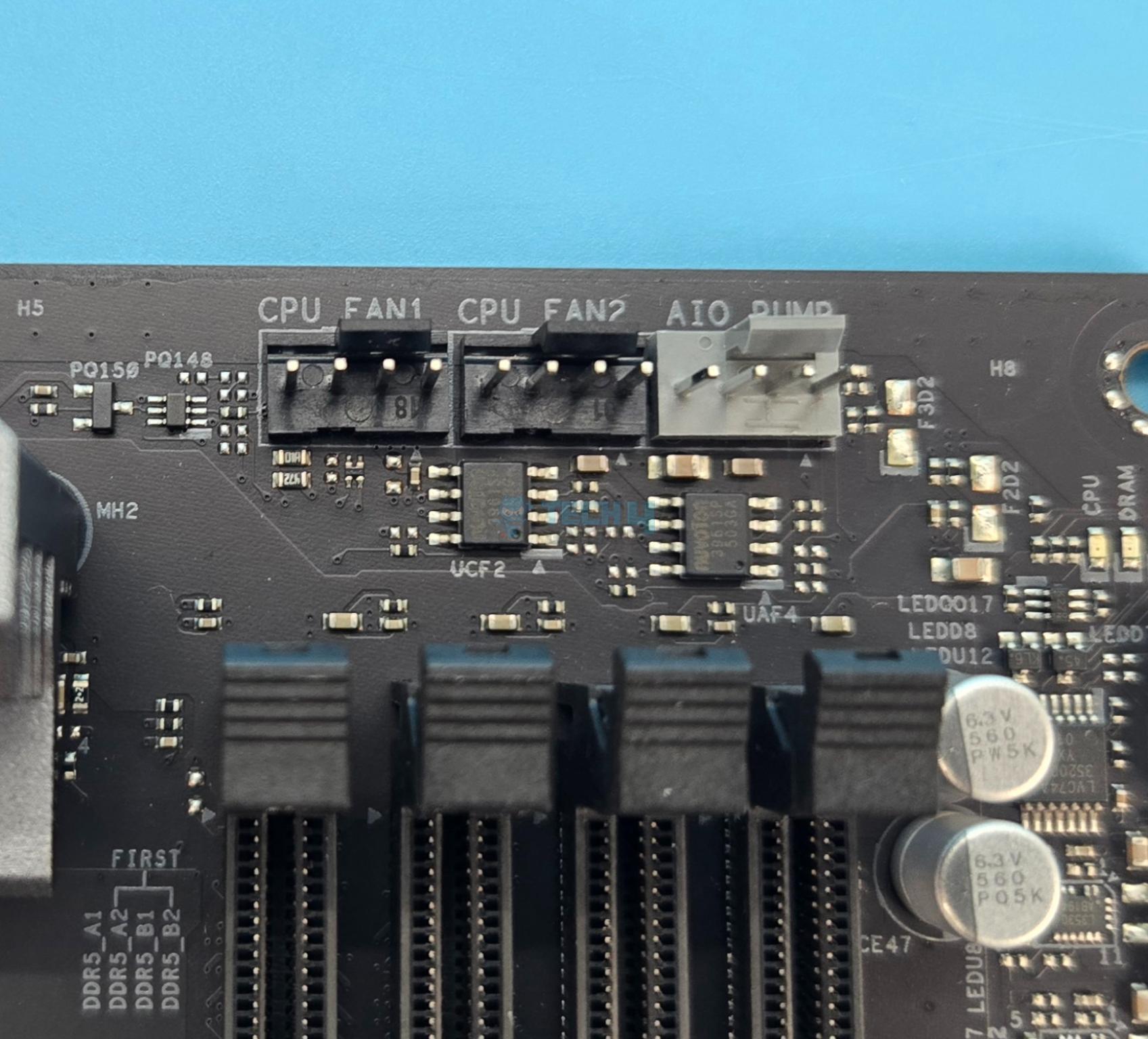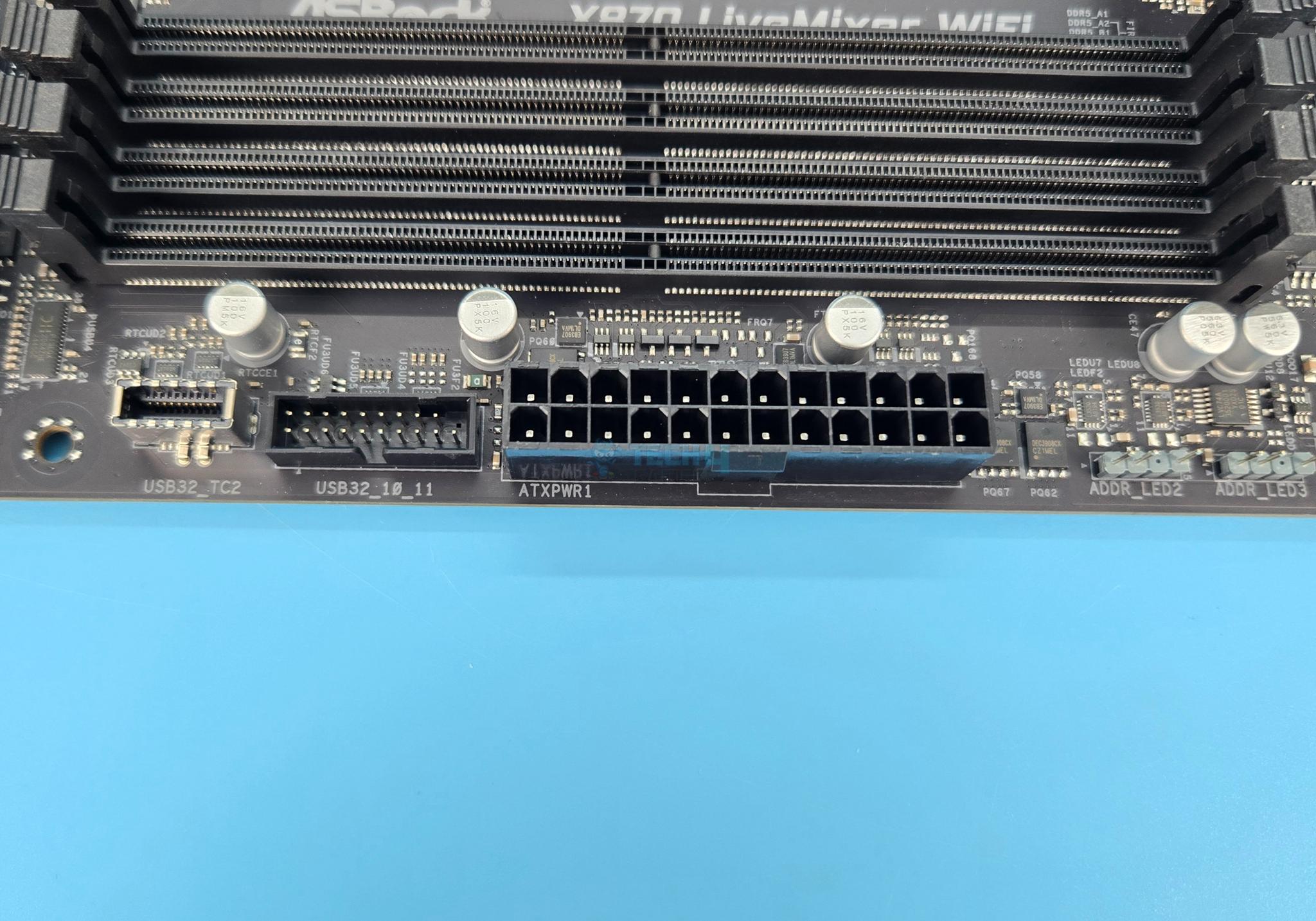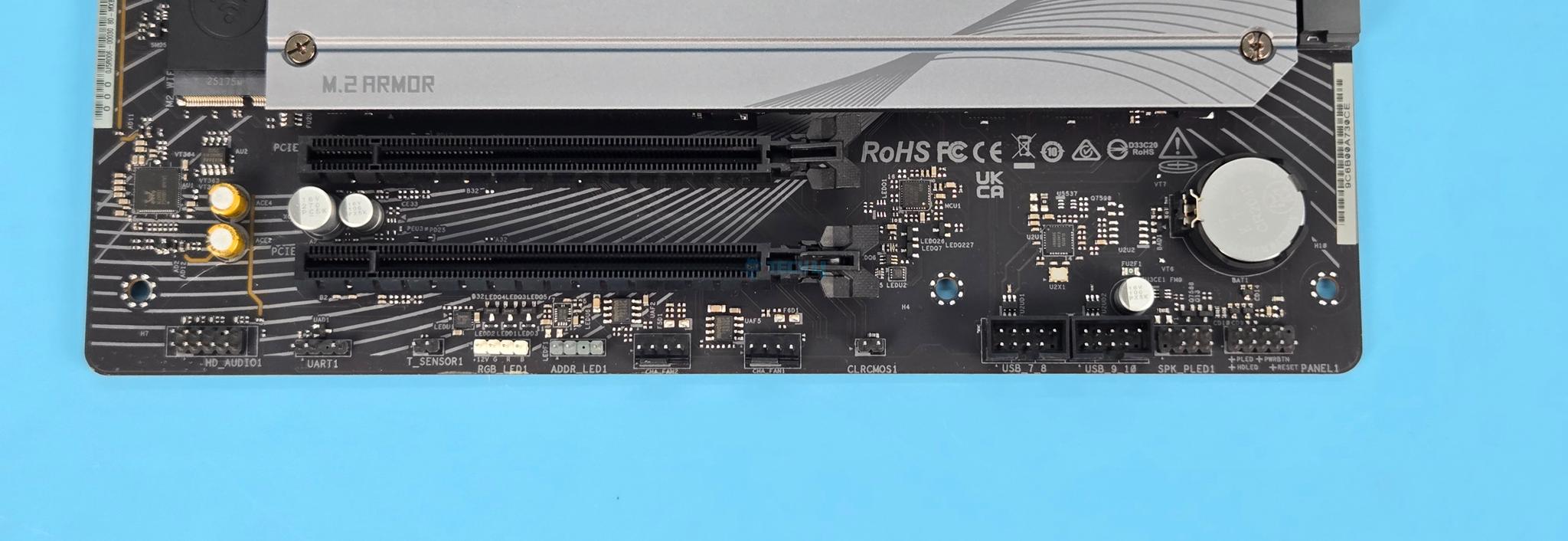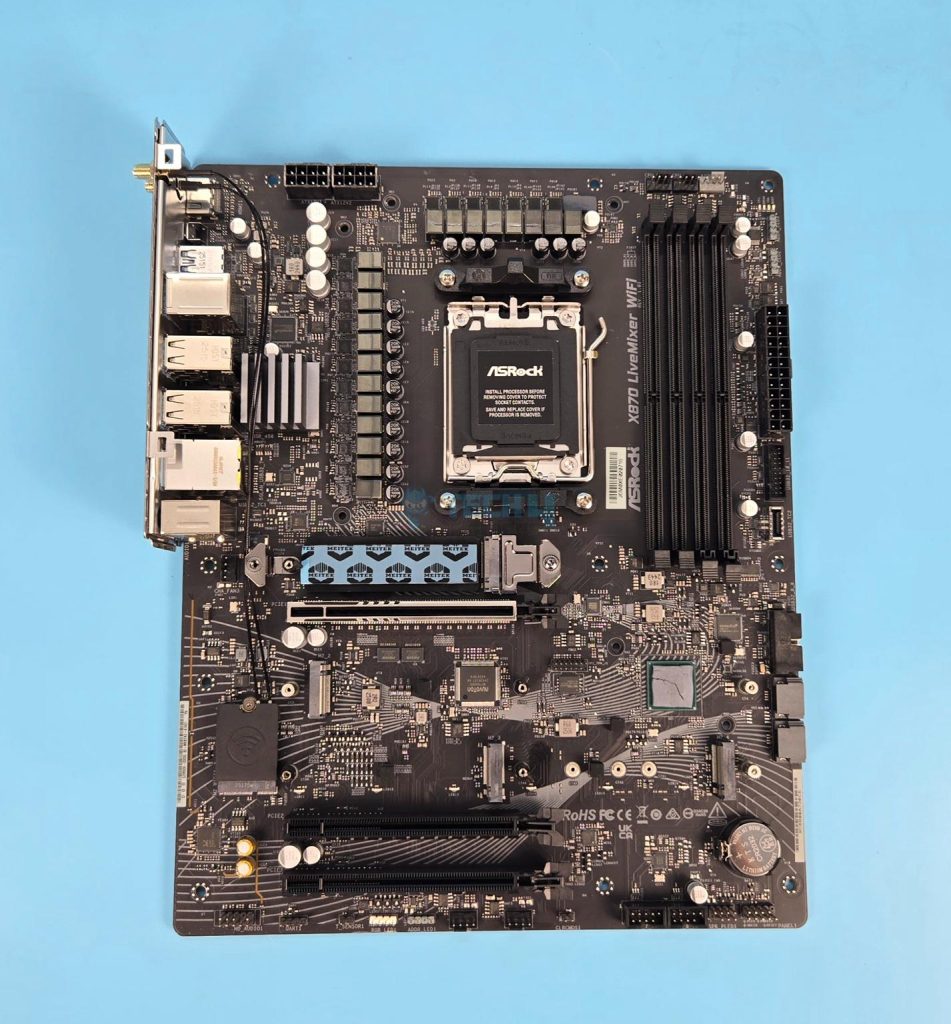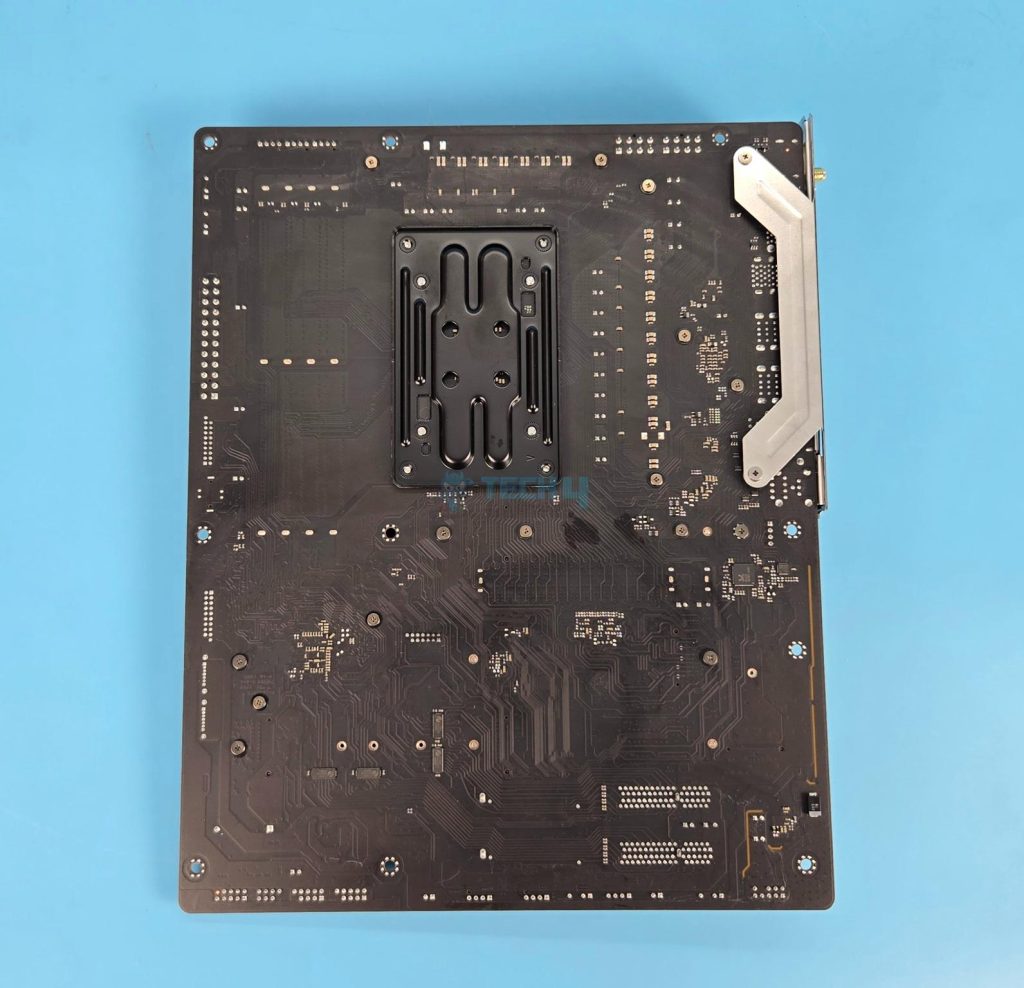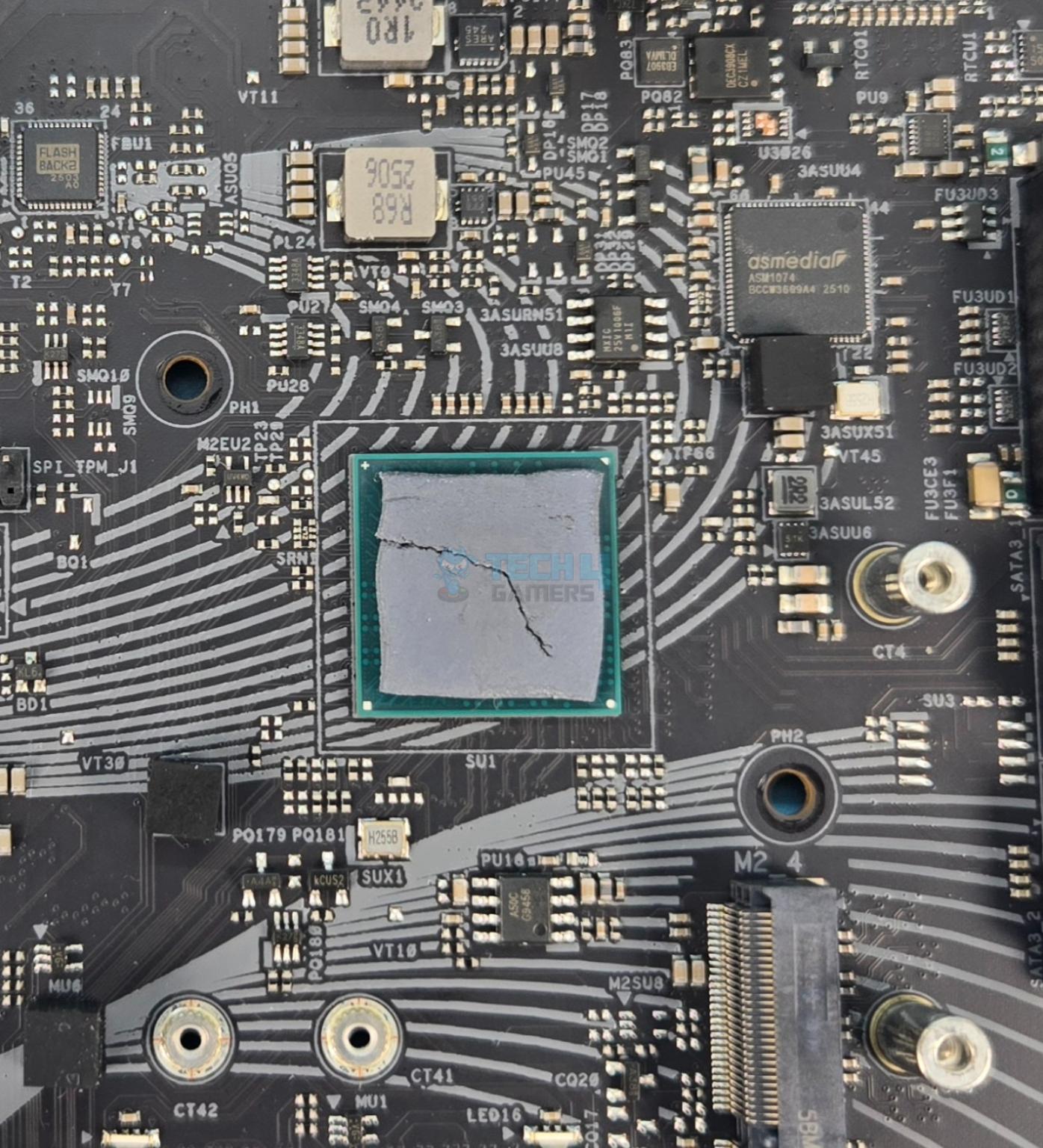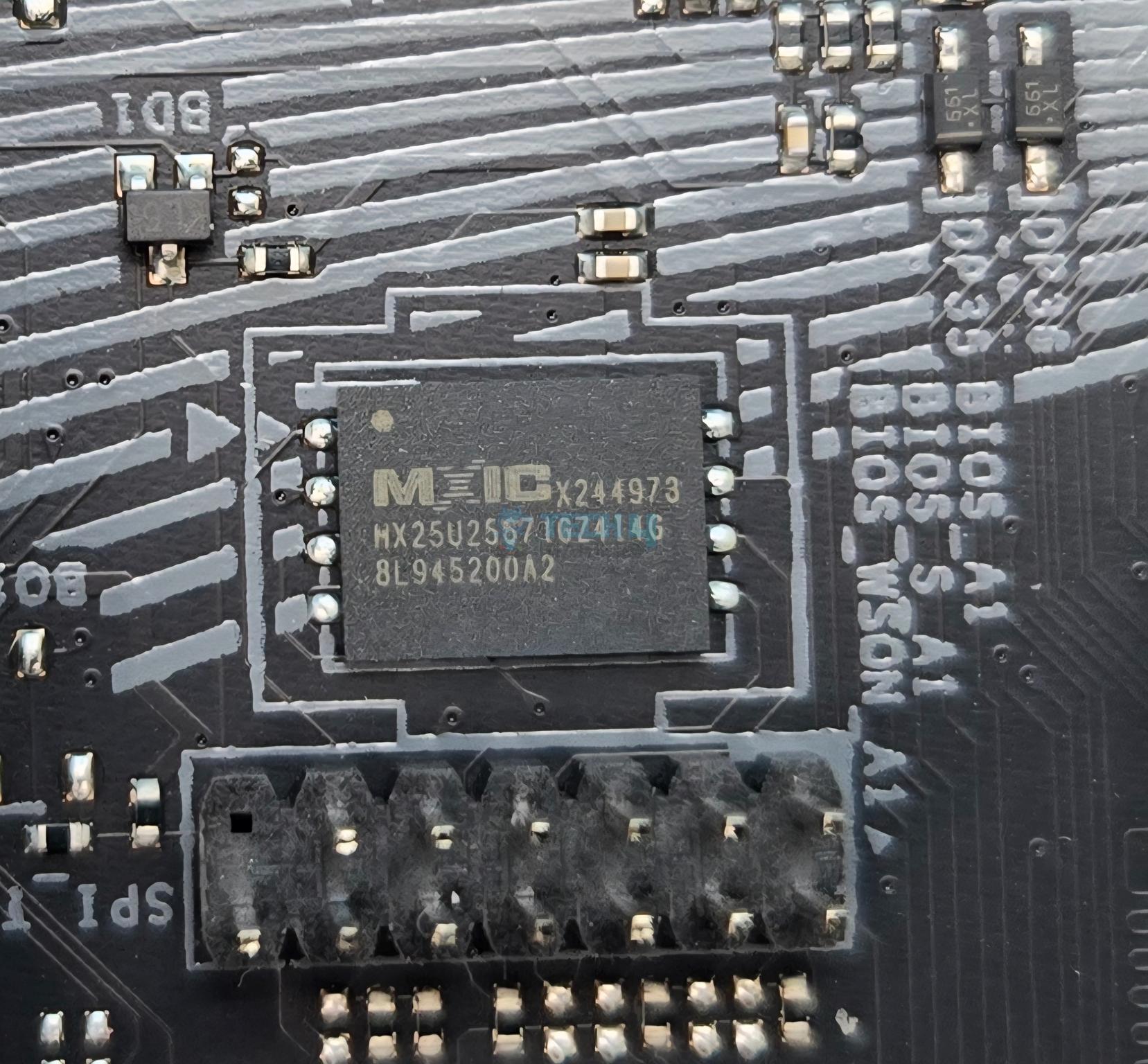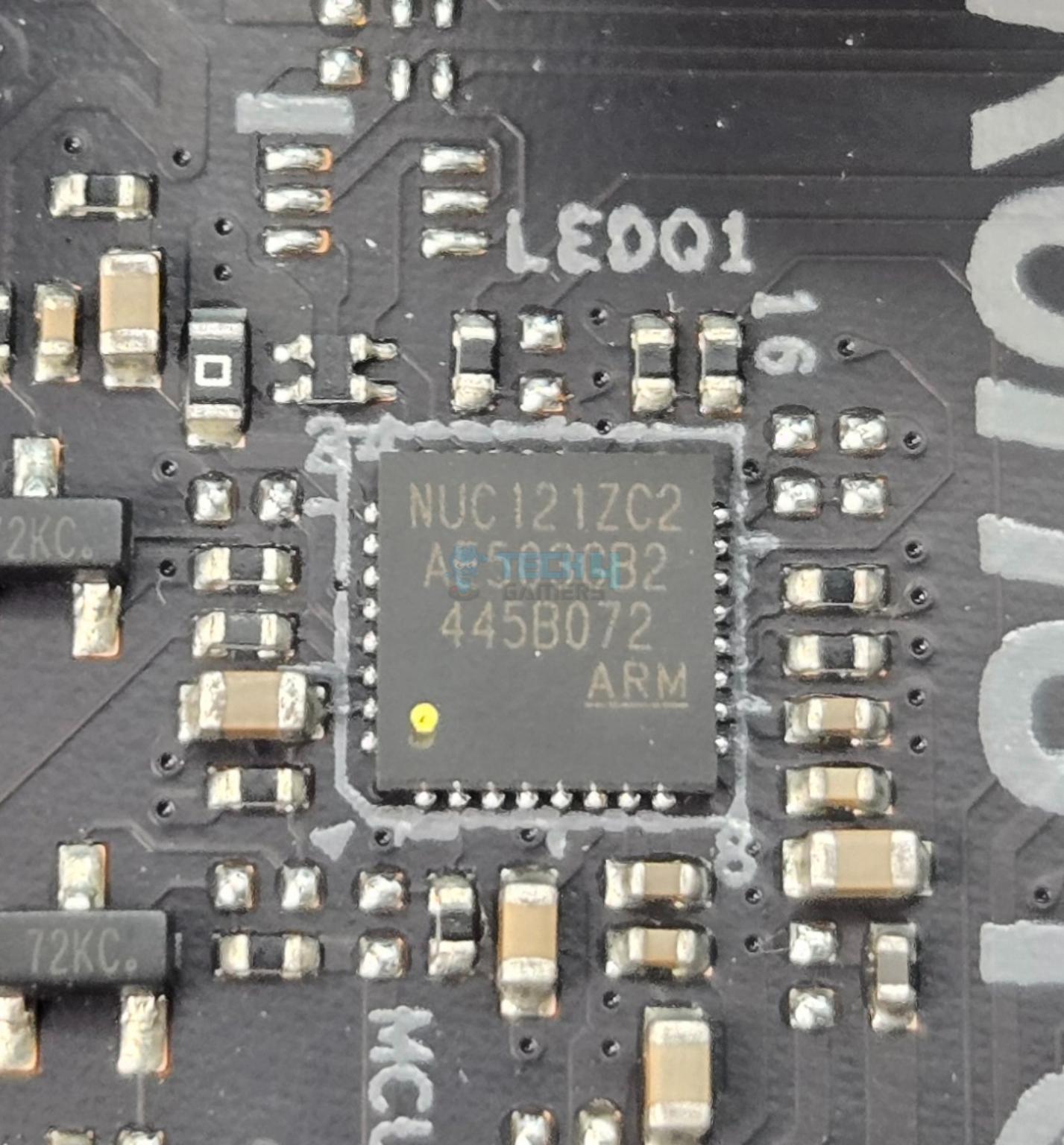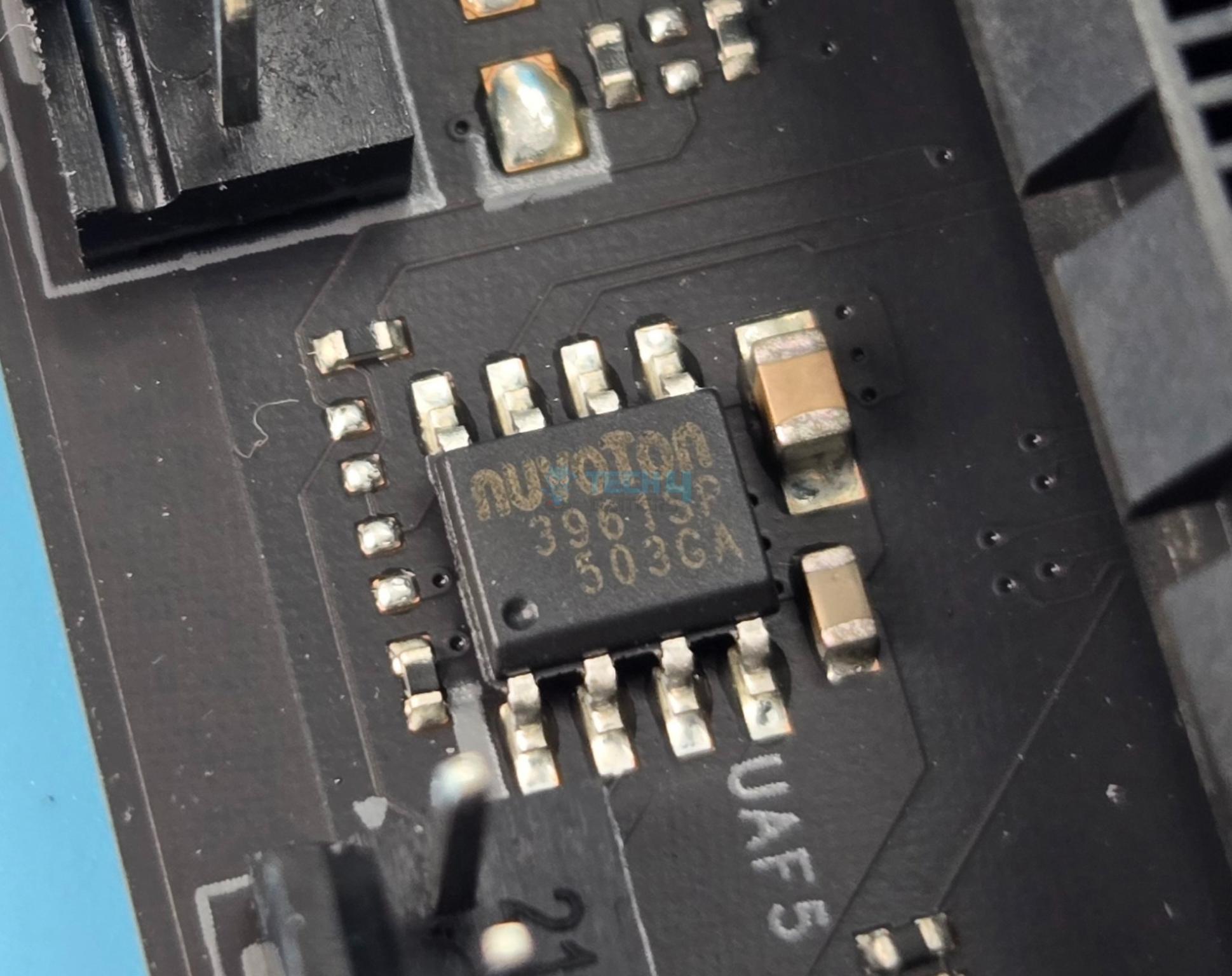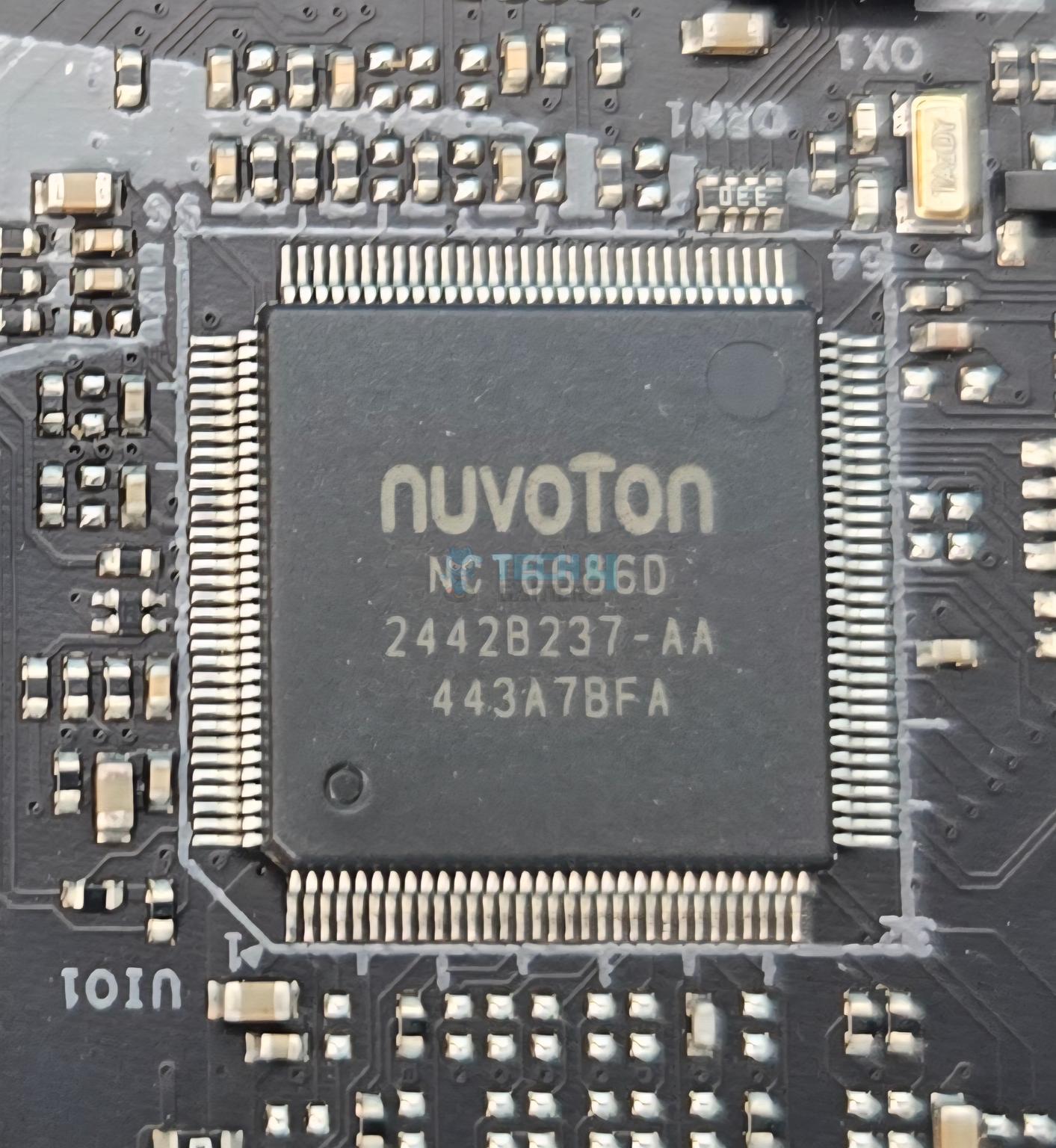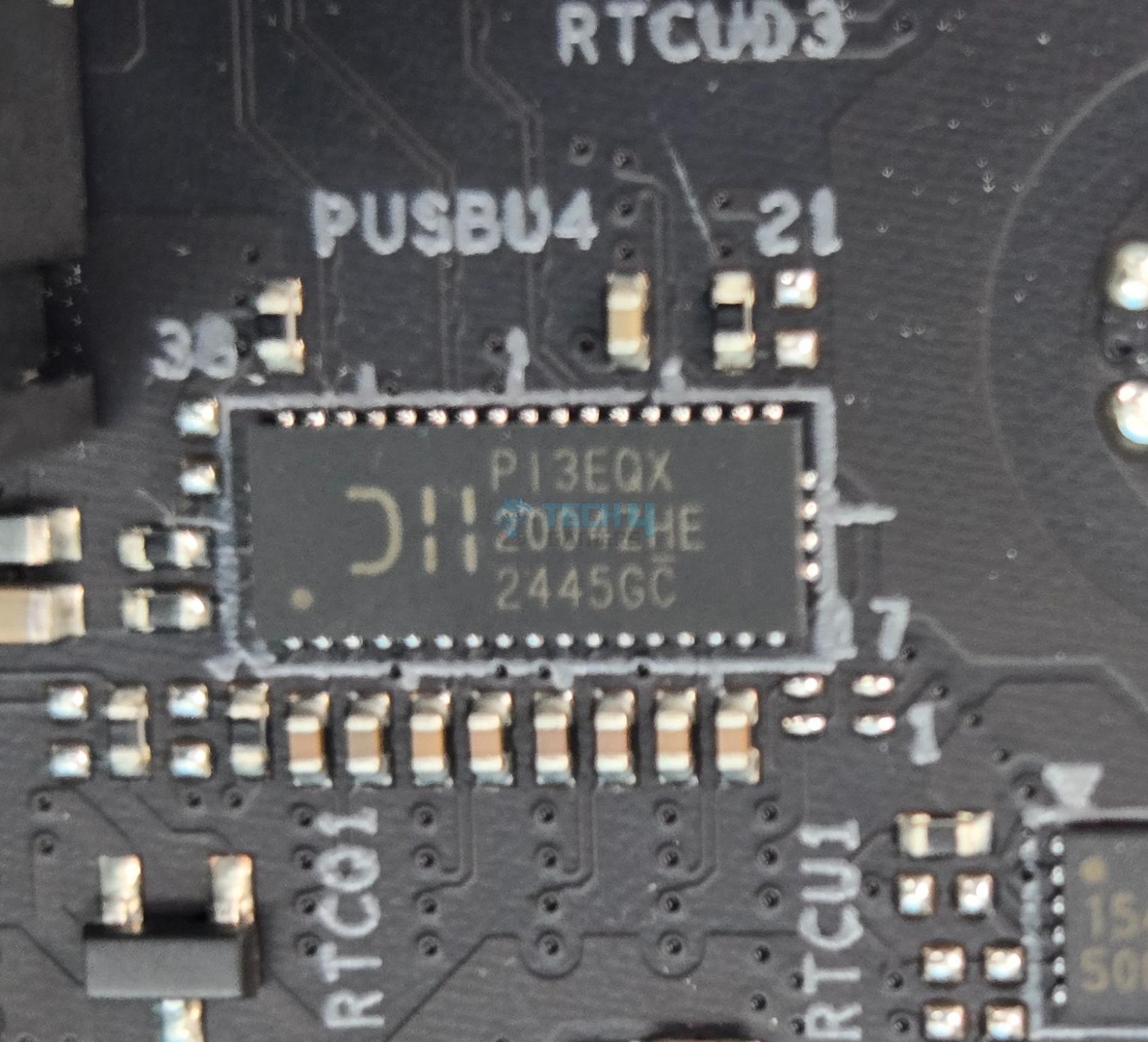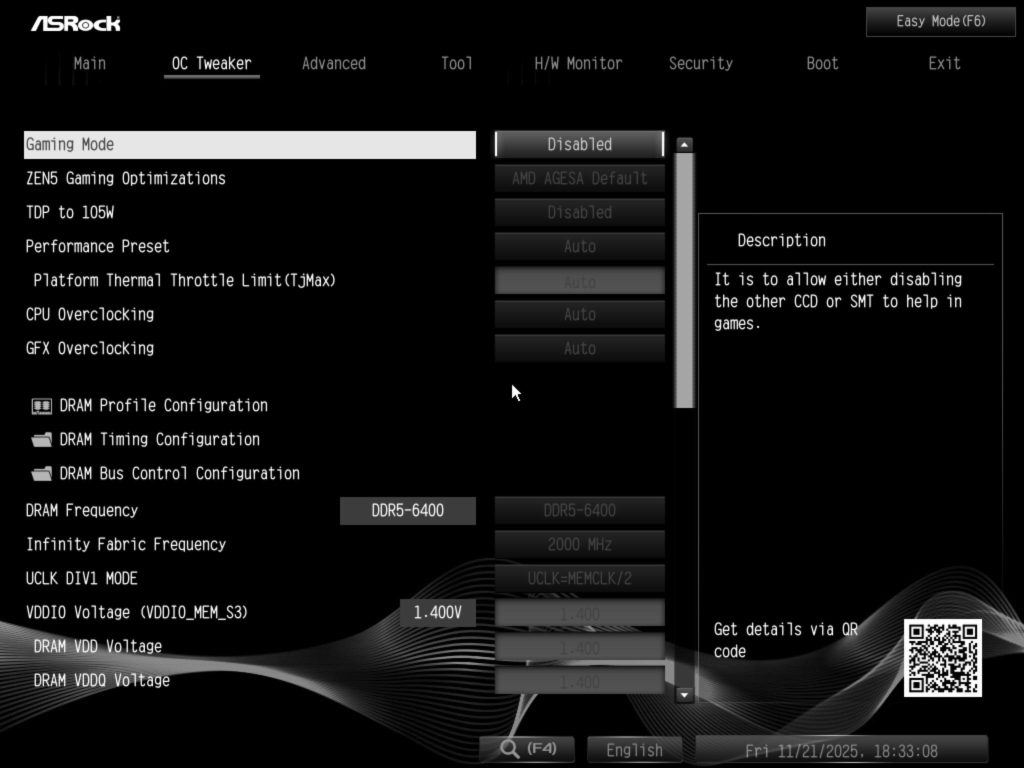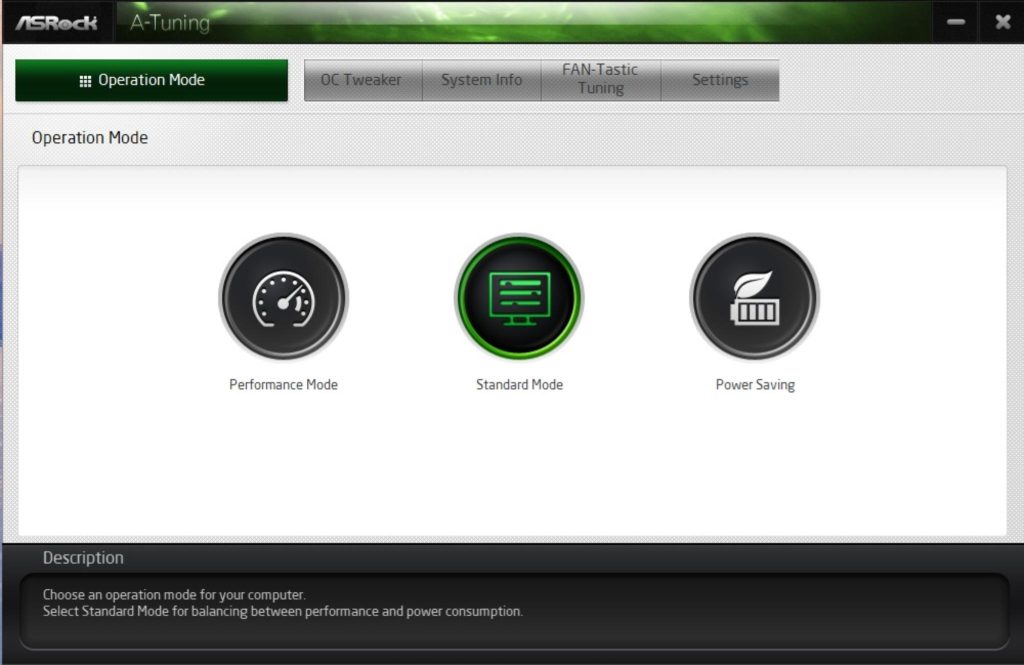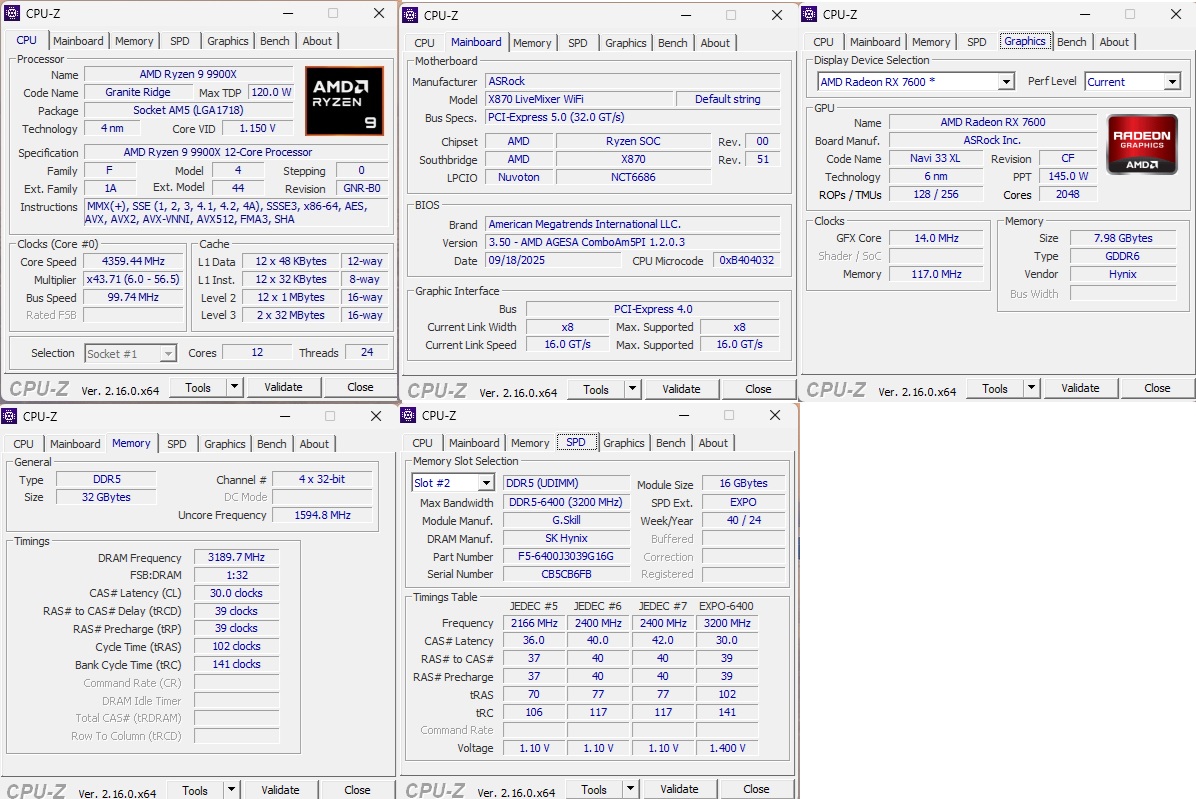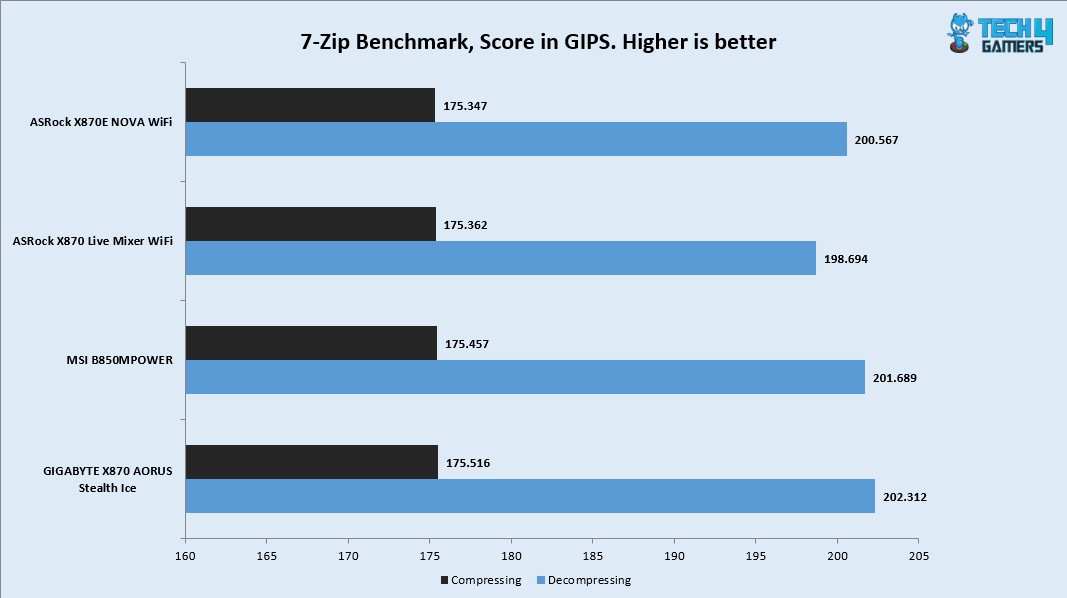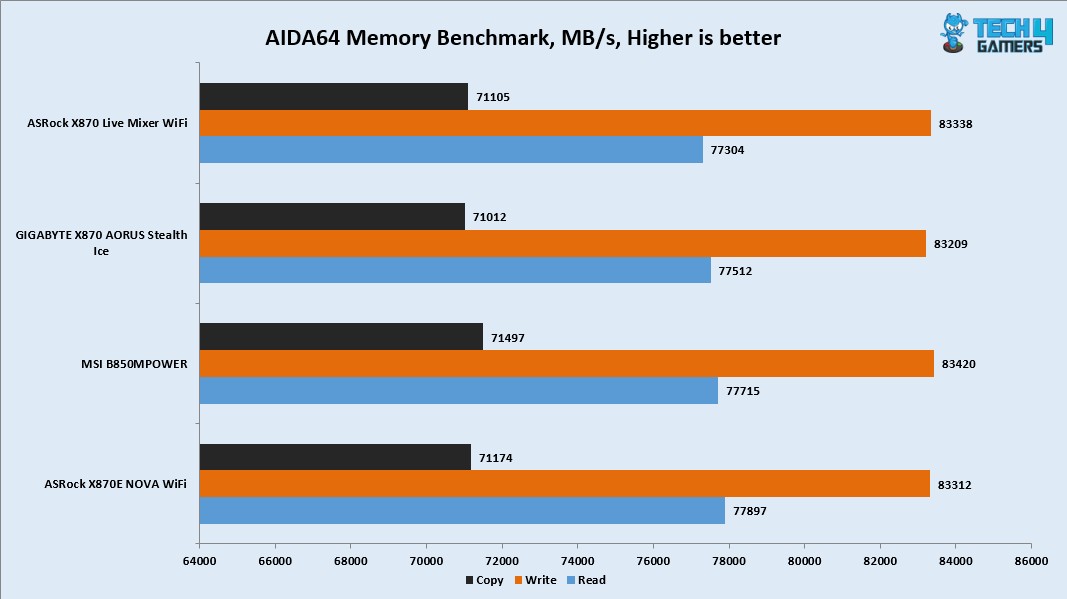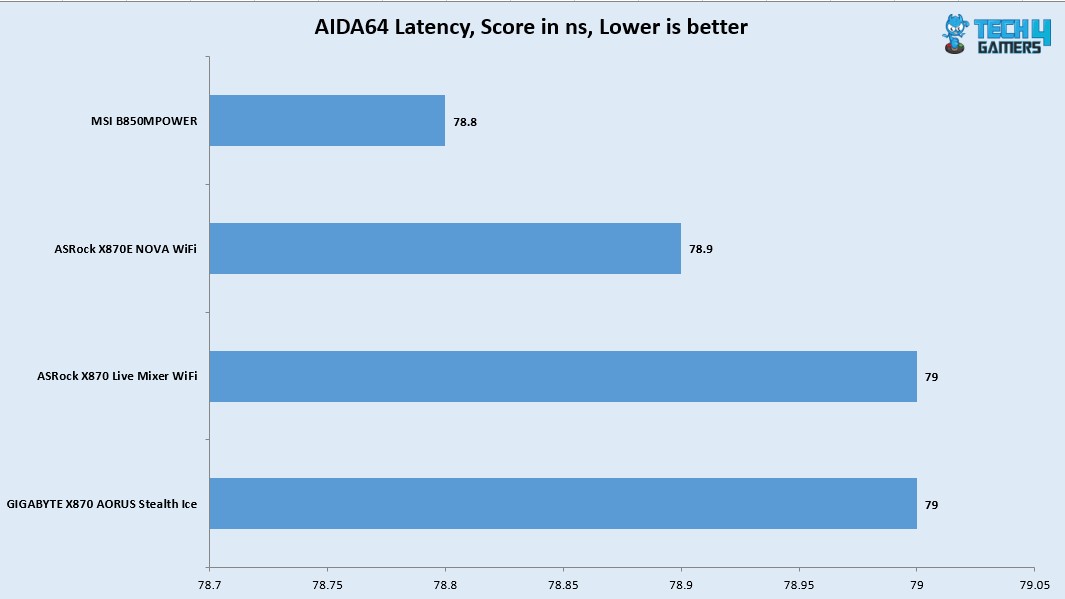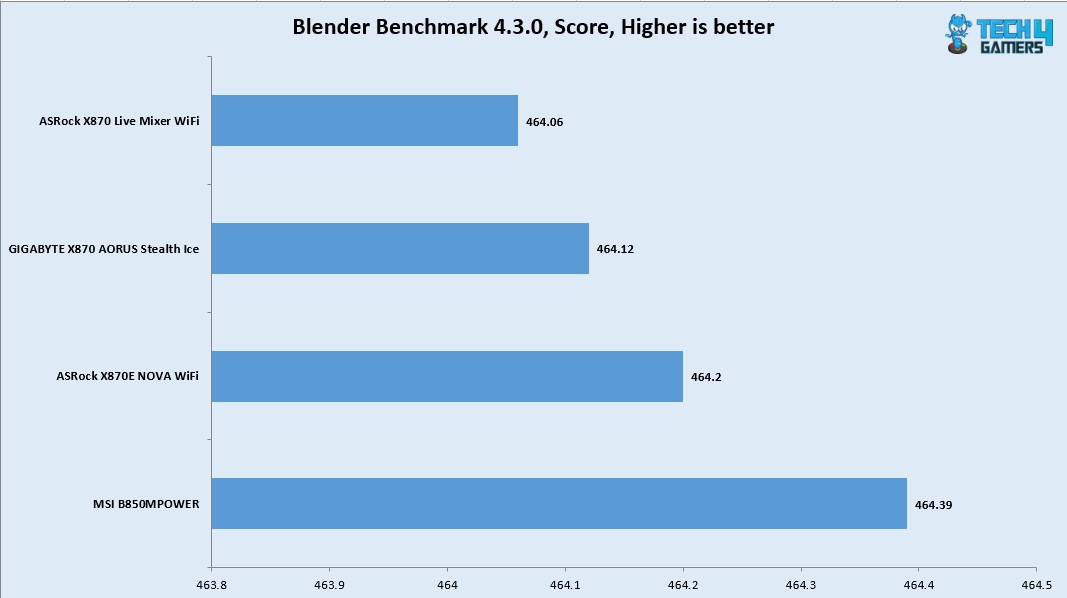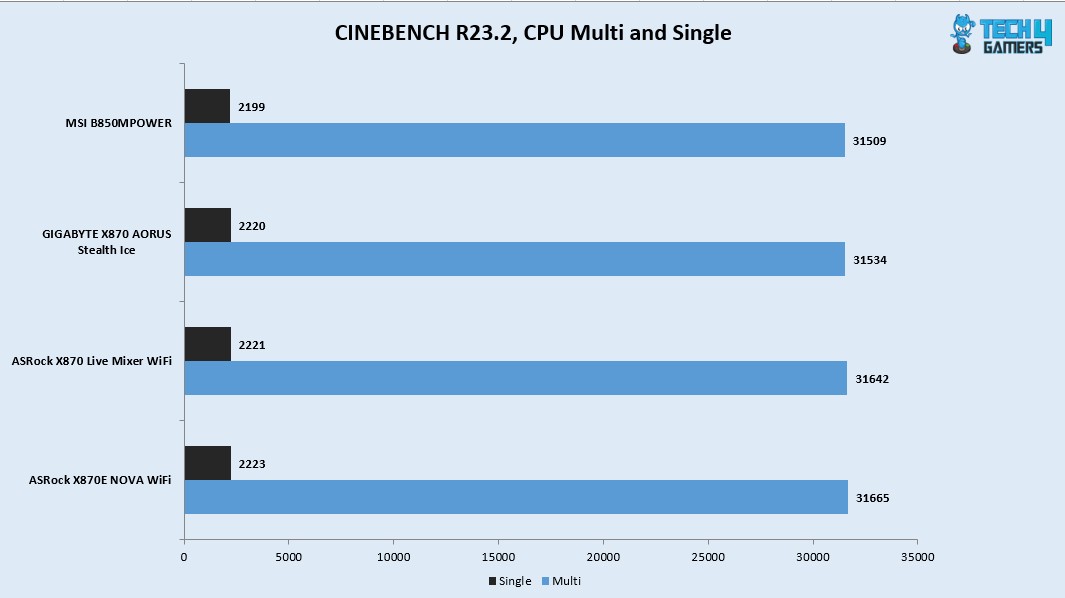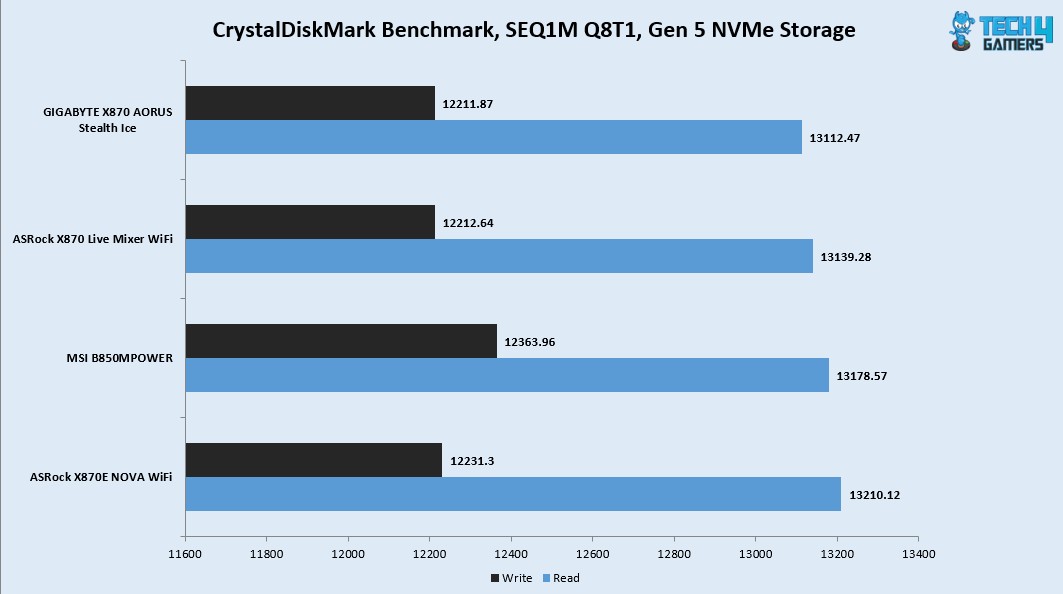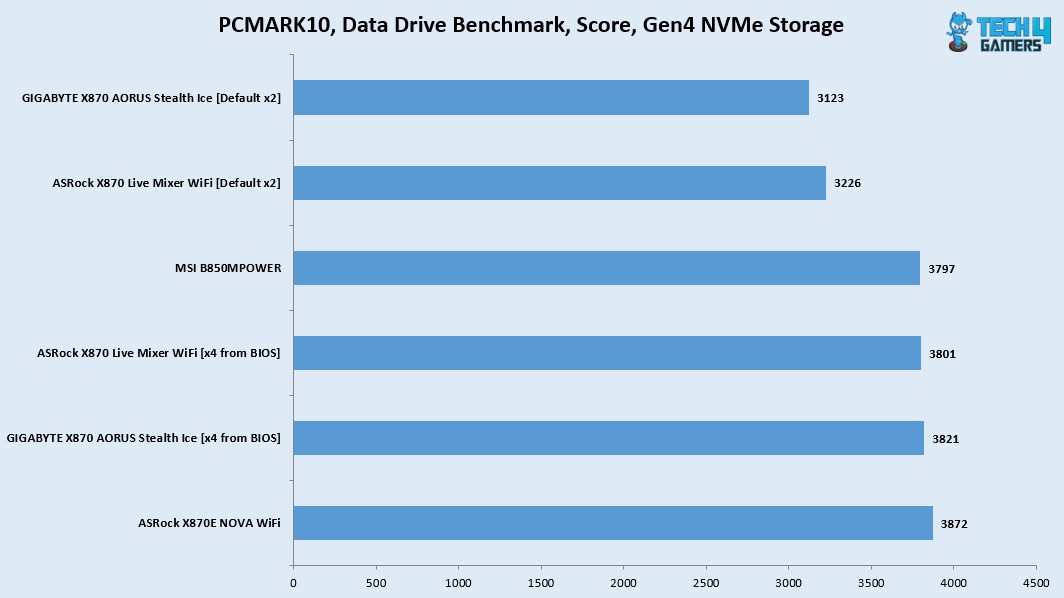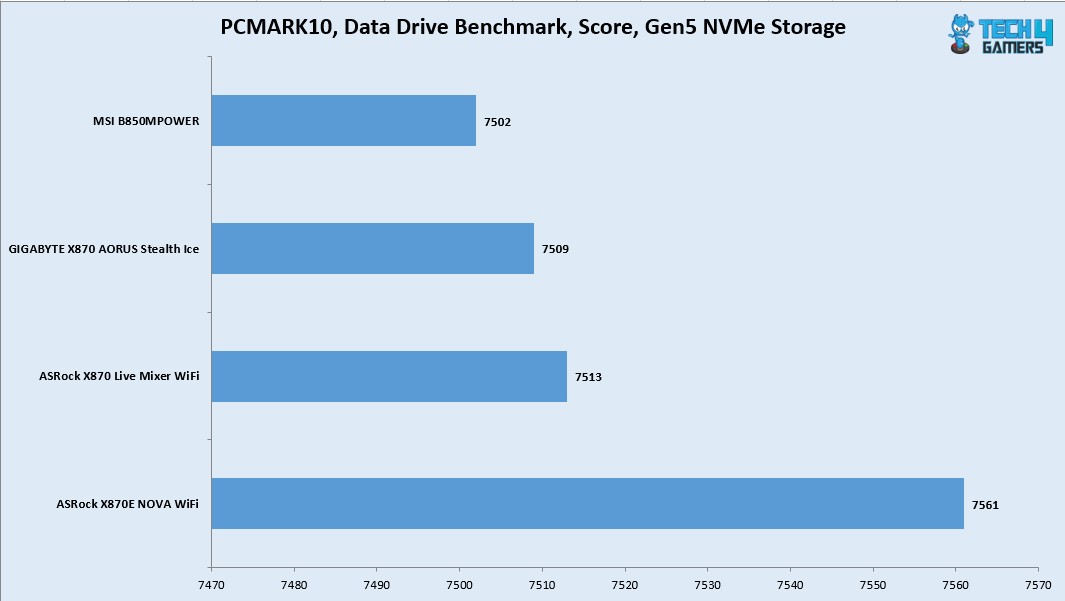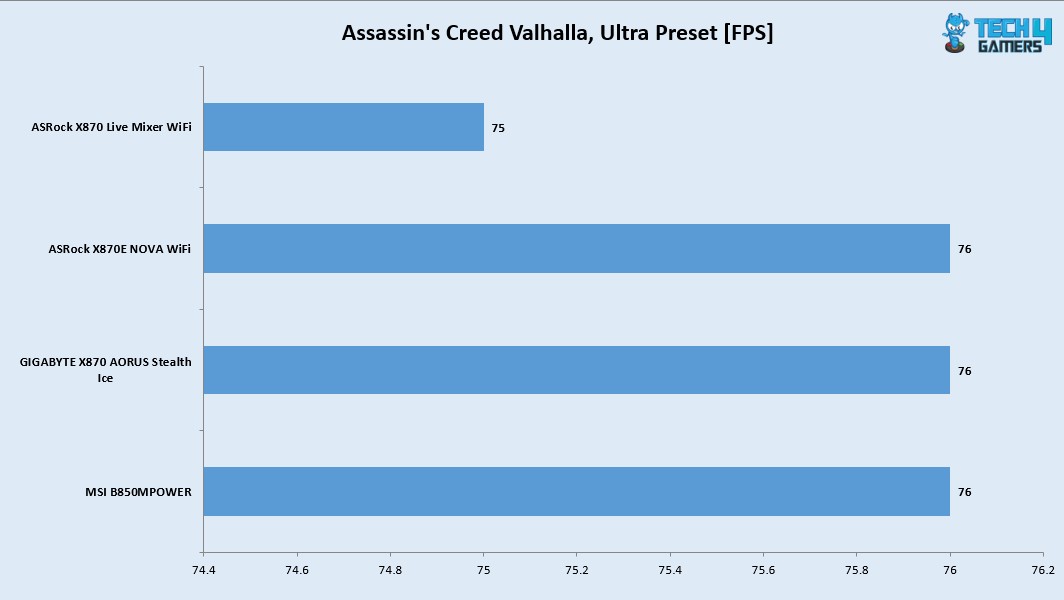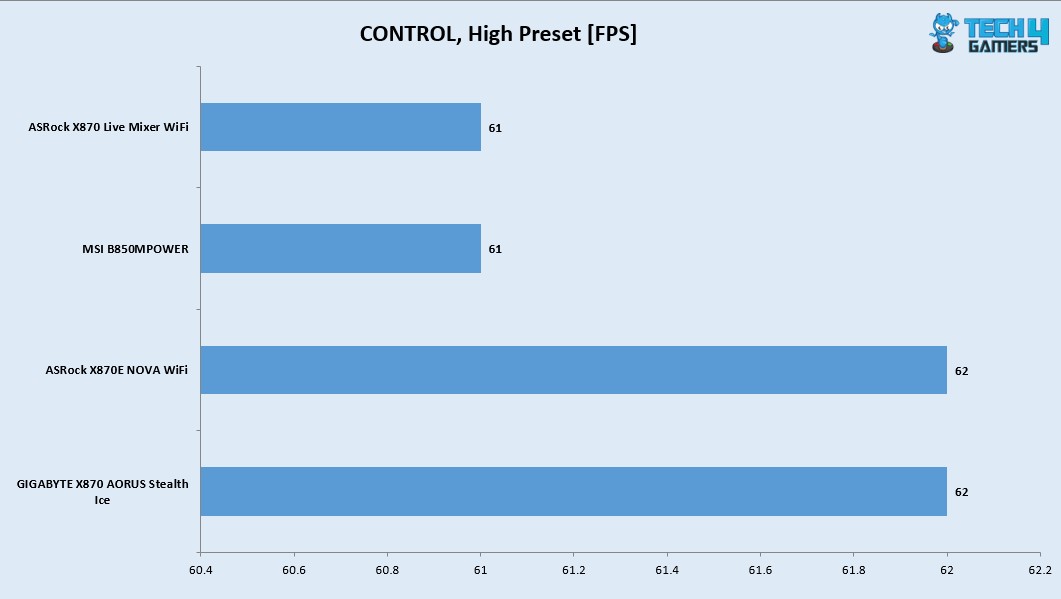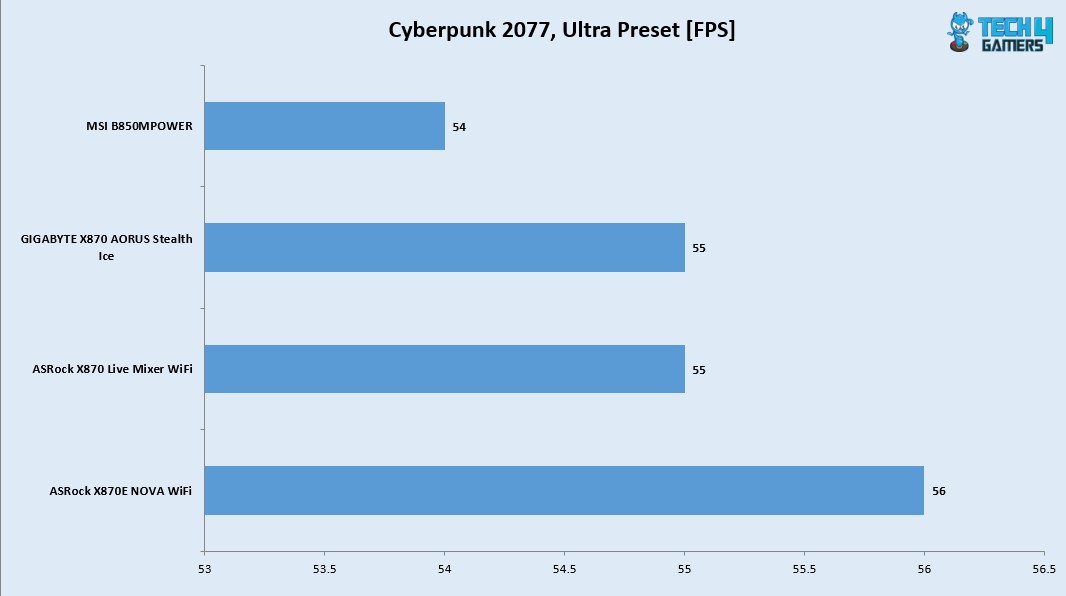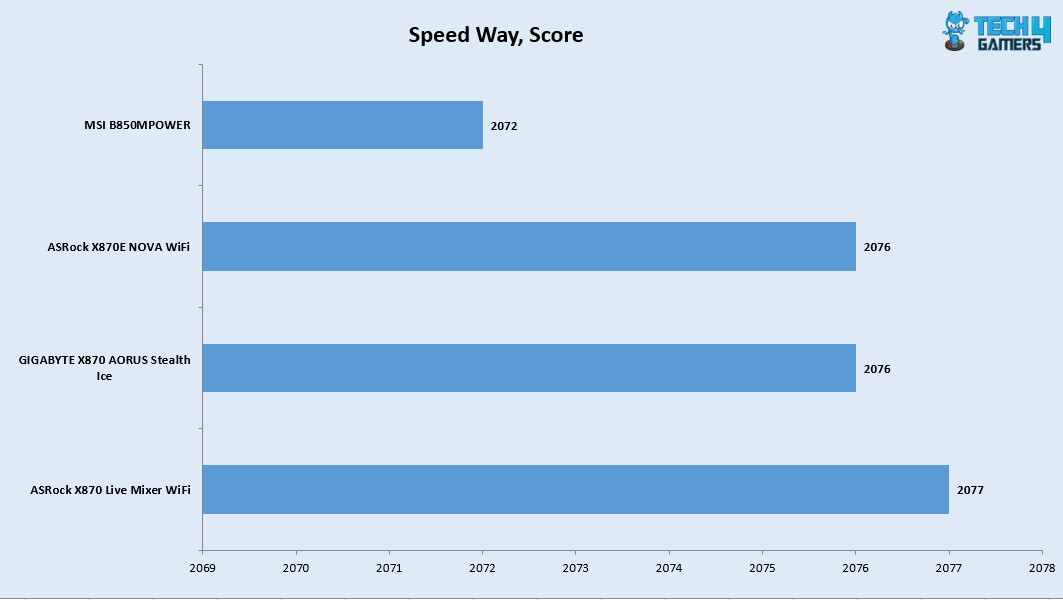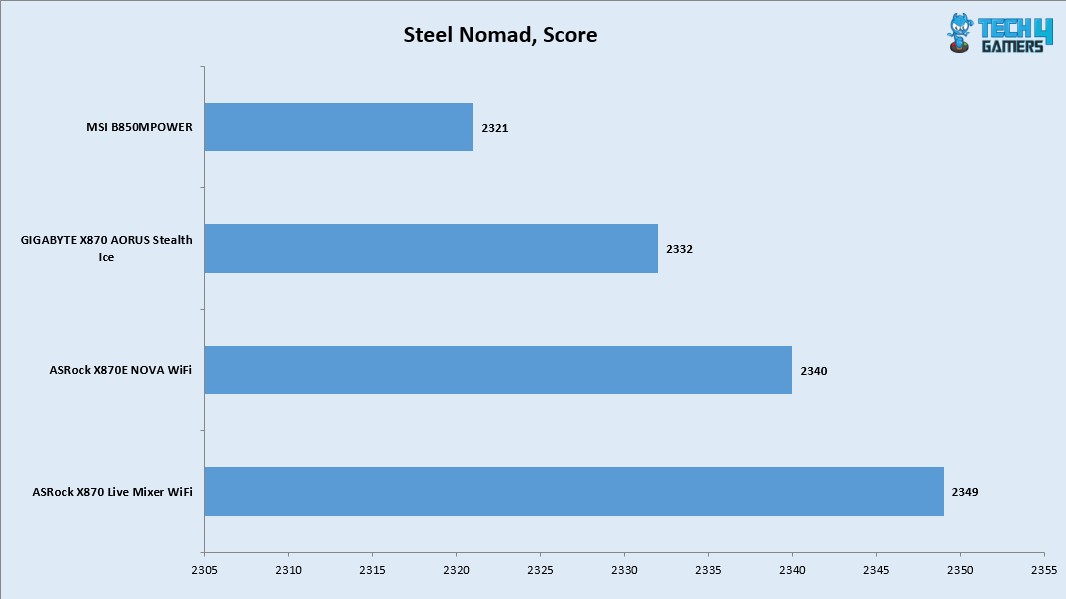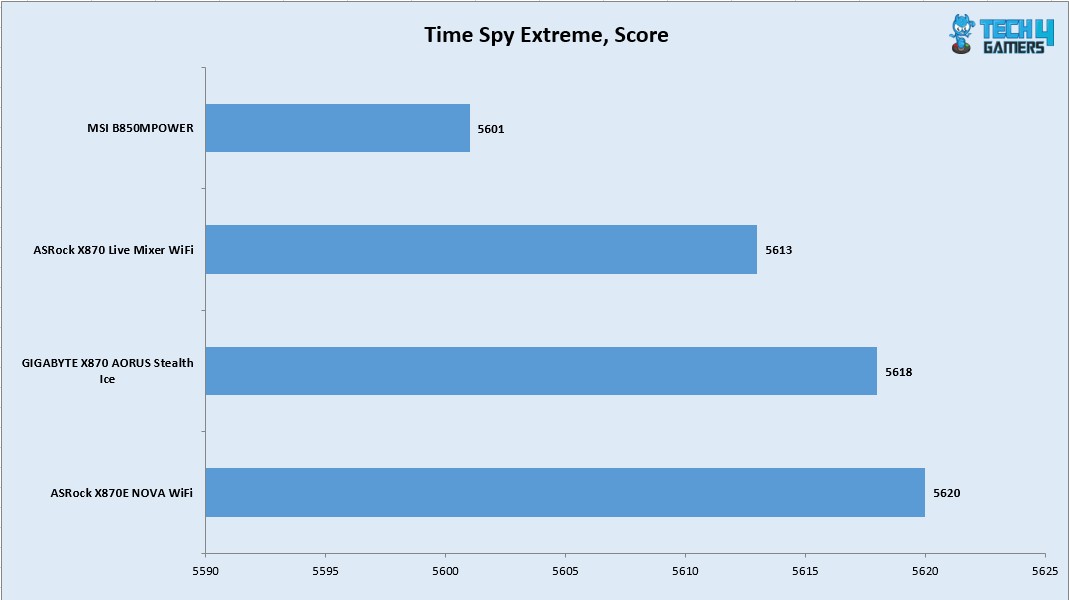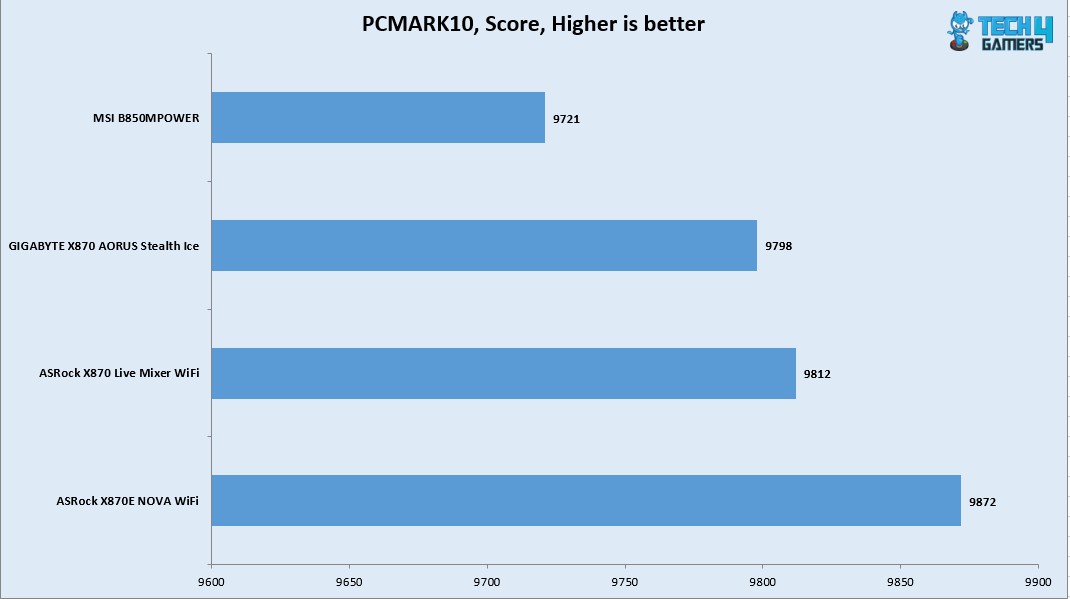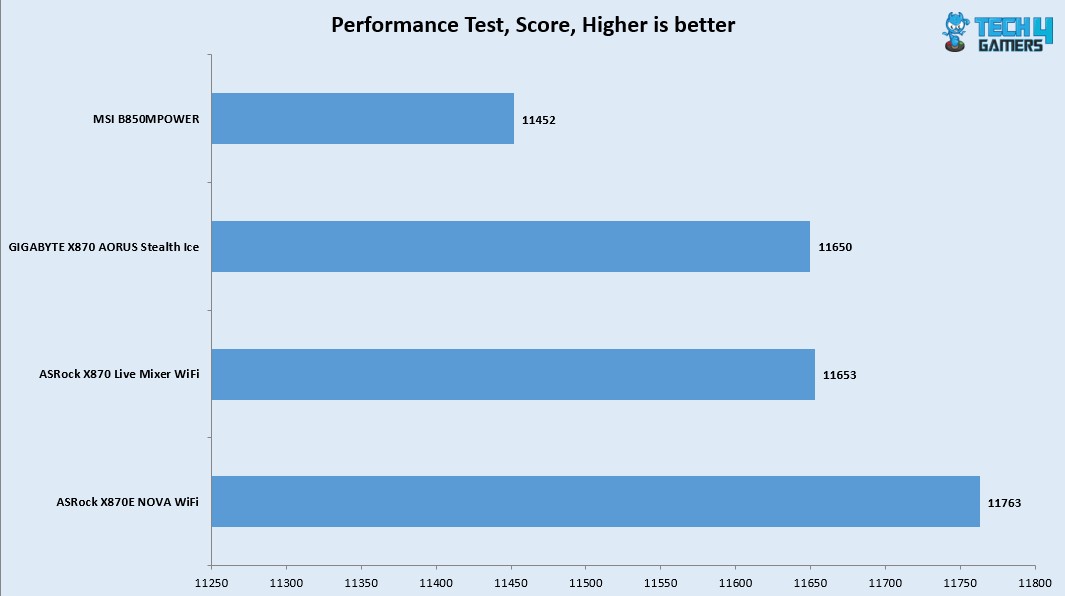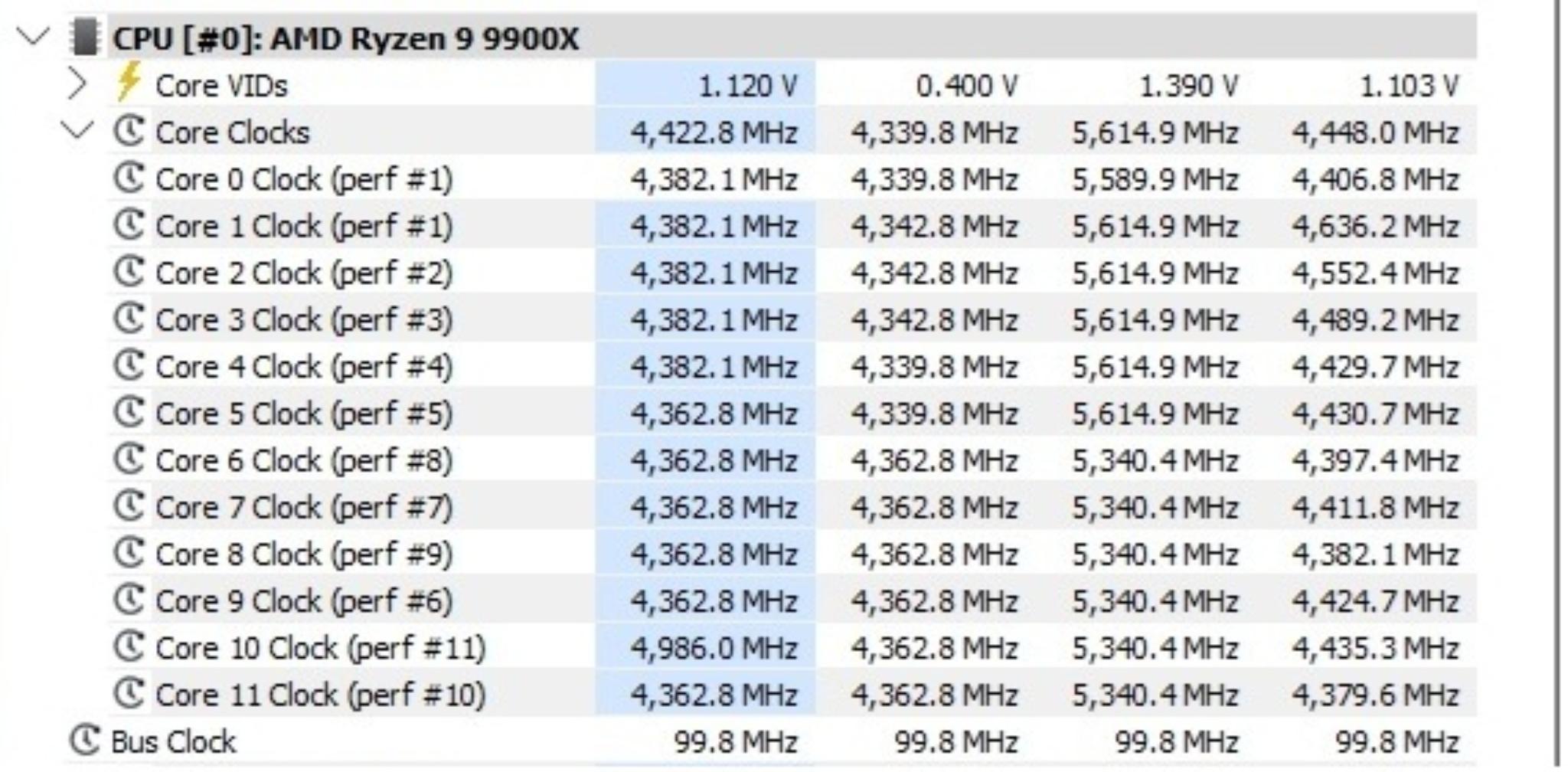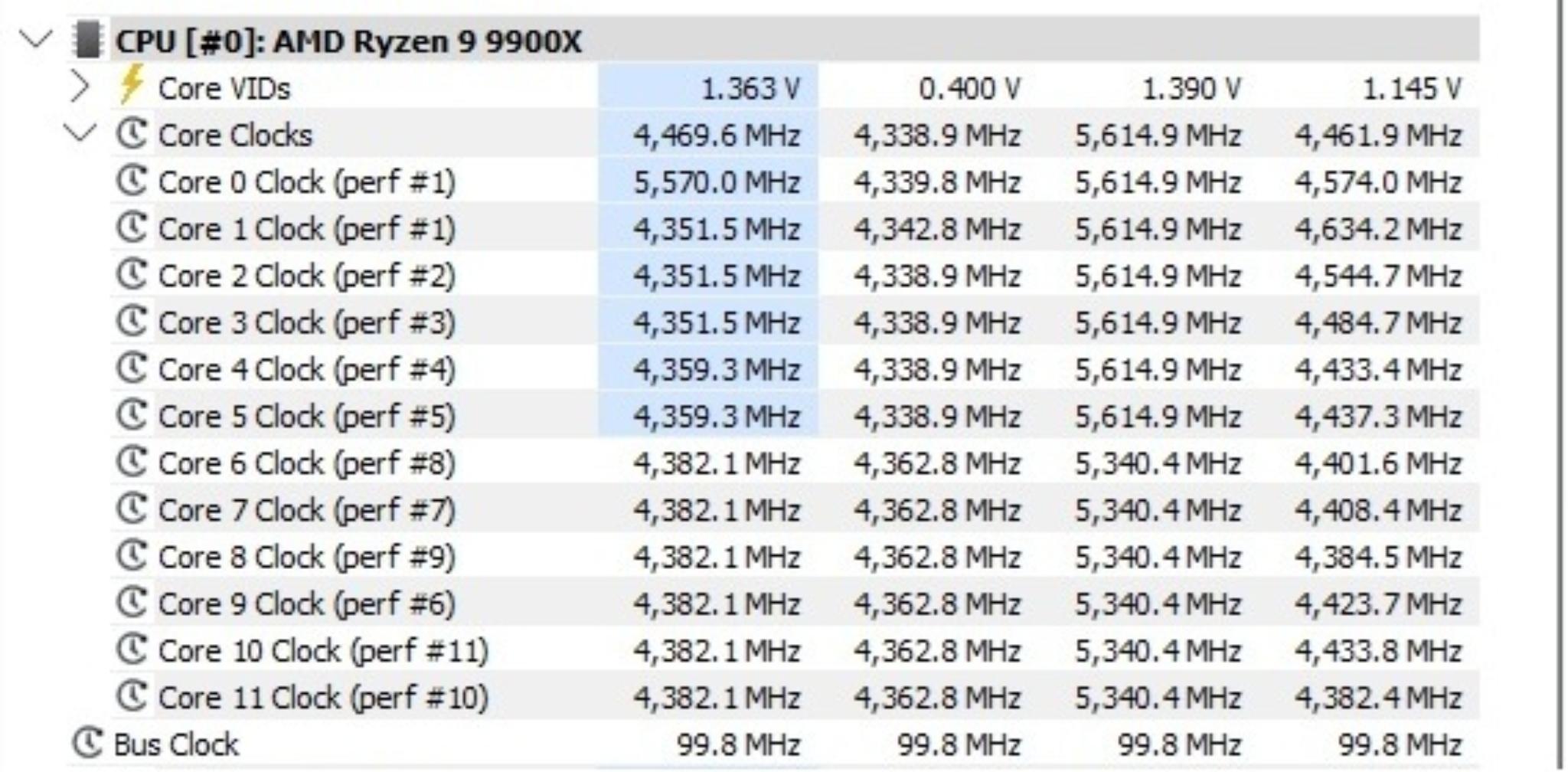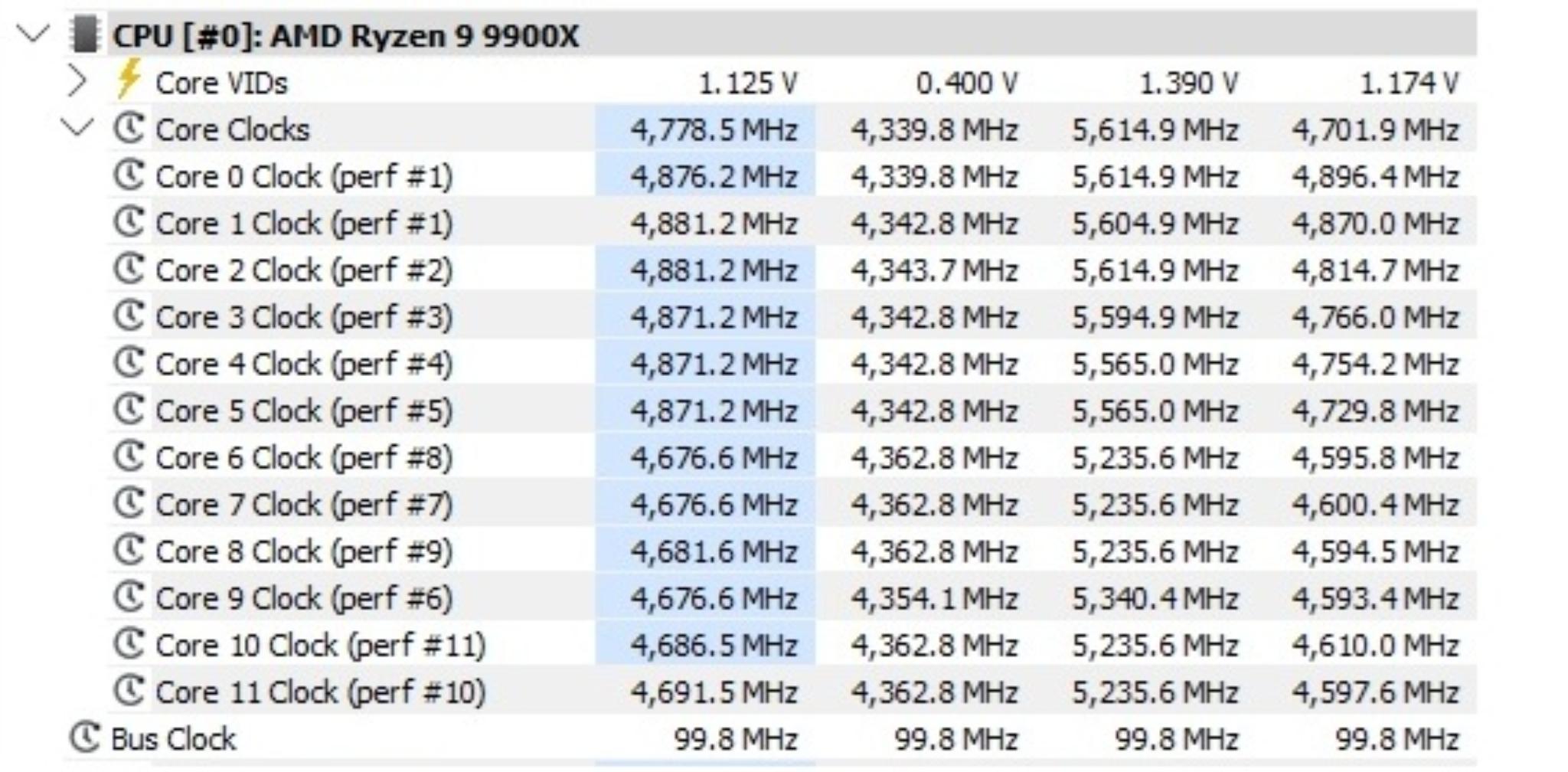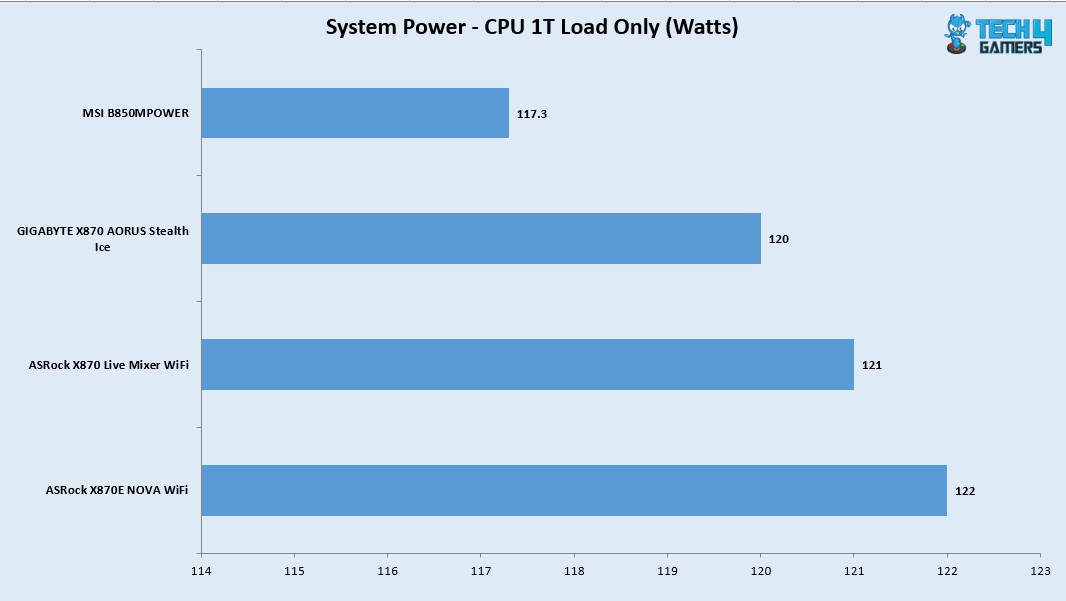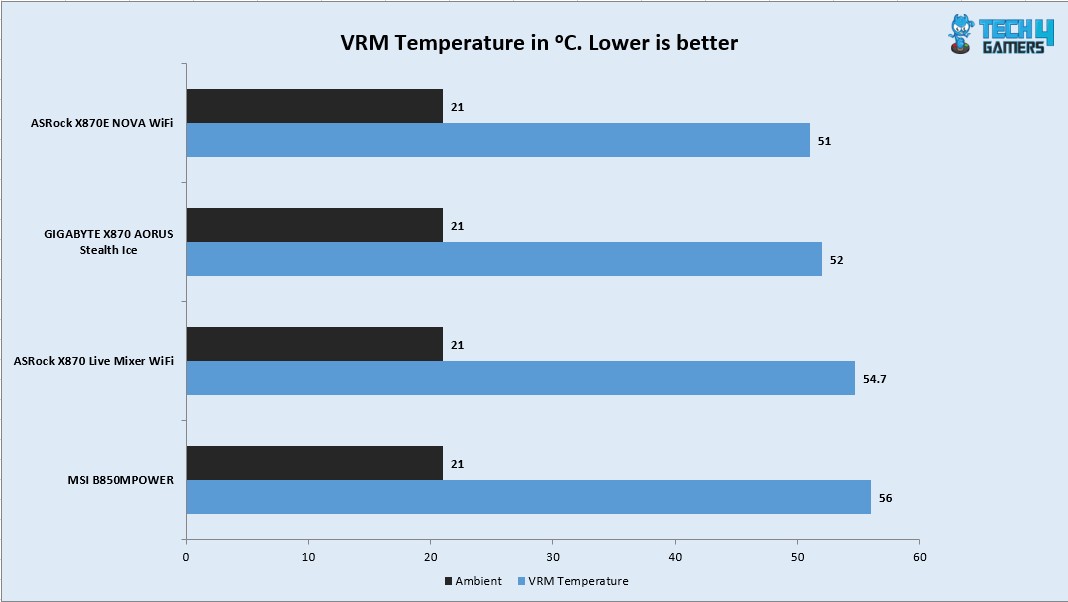Worth It?
Review Summary
The ASRock X870 Live Mixer WiFi is a budget-friendly motherboard that includes all the essential features content creators need, especially those focused on video capture, thanks to its three PCIe x16 slots and 25 USB ports. Its give-and-take design approach reflects the platform’s inherent limitations, but it still provides excellent versatility. This motherboard is an ideal choice for both gaming and content creation.
Hours Tested: 13
Overall
-
Design - 8/10
8/10
-
Features - 8.5/10
8.5/10
-
Performance - 8.5/10
8.5/10
-
Value - 9/10
9/10
Pros
- Gen4 M.2 Ports
- PCIe Gen5 Steel-Reinforced Slot
- 2× USB 4.0 Type-C Ports
- 1× 5GbE LAN Port
- WiFi 7 Module and Antennae
- 25× USB Ports
- Price
- Warranty
Cons
- Devices sharing buses
- Only 2× SATA Ports
- Basic WiFi 7 connectivity
The Live Mixer series from ASRock aims towards the content creators in particular, where focus is more on the connectivity and productivity, hence you may see less beefier power delivery design compared to gaming motherboards. Nevertheless, these motherboards are still well equipped for your gaming needs.
The ASRock X870 Live Mixer WiFi motherboard, priced at only USD 230, features 25 USB ports and 3x PCIe slots, providing a ton of connectivity options for content creation. This motherboard also consists of WiFi 7, a 5GbE LAN port, and an ALC4082 audio solution.
The salient features include:
- This motherboard supports AMD Ryzen™ 9000, 8000, and 7000 Series Processors
- It is equipped with 16+2+1 Power Phases
- It supports Dual Channel DDR% up to 8000+ (OC)
- It is equipped with 1 PCIe 5.0 x16, 2 PCIe 3.0 x16
- Audio Solution is from Realtek ALC4082
- Total of 4x M.2 slots and 2x SATA ports
- 2 USB4 Type-C (Rear)
- 1 USB 3.2 Gen2x2 Type-C (Front)
- Realtek 5GbE LAN and 802.11be WiFi 7 + Bluetooth
| Form Factor | ATX |
| CPU Support | AMD Socket AM5 Series Desktop CPUs |
| CPU Socket | LGA1718 AM5 |
| Memory Support | 4x DDR5 DIMM Slots |
| PCIe Support |
|
| On-board Graphics |
|
| Storage |
|
| USB Ports | 25x USB Ports including 2x USB4.0 Ports |
| LAN | 5 Gbps RealTek RTL8126 |
| WiFi |
|
Packaging And Unboxing
The main packing box is made of cardboard material. It has a black and purple color scheme. The motherboard is placed inside an anti-static container. The salient specifications and features are listed on the packing box. ASRock has included the following in the box:
- 1x ATX-sized Motherboard
- 2 x SATA Data Cables
- 2 x ASRock WiFi 2.4/5/6 GHz Antennas
- 1 x Thermistor Cable
- 2x Velcro Strips
- 1x Quick Installation Guide
- 1x Regulatory Notice
Design Overview
ASRock X870 Live Mixer WiFi motherboard is driven by an AMD LGA1718 AM5 socket controlling the 4x DIMM slots. HDMI port, MCU, Flash Back BIOS are all handled by the CPU socket. SIO NCT6686D is also wired to the CPU socket. PCIe Gen5x16 slot is wired to the socket along with 2x M.2 Gen5x4 ports.
However, M2_2 is PCIe Gen5 shares bus with 2x USB 4.0 ports, hence it operates at Gen5x2 by default unless you disable USB4 ports in the BIOS. This motherboard’s PCB is an 8-layer design using 2Oz thickened copper.
The DMI link operates at x4 PCIe between the socket and chipset. The rest of the connectivity comes from the X870 PROM21 chipset, including 2x Gen4x4 M.2 slots, 2x PCIe Gen3x16 slots, WiFi 7 solution, Intel NUC, SATA, USB ports, Serial IO, and Audio solution.
M2_3 shares a bus with PCIE2, making them both operate at x2 speeds. The same goes for the M2_4 and PCIE3 slots. The front USB 3.2G20 port uses ReDriver and is wired to the chipset.
Power Delivery To Socket
This motherboard is powered by an LGA1718 AM5 socket supporting AMD Ryzen 7000, 8000, and 9000 series desktop CPUs. It uses an ILM mounting mechanism.
Two aluminum heatsink covers are over the power delivery circuit. They are light gray and silver textured. They have cutouts for effective heat ventilation. This design does not use a heat pipe, and these covers don’t have any backlighting.
This motherboard has a total of 19 power phases, arranged in 16+2+1 for VCore, MISC, and SOC. Each is rated for 80A Vishay SiC 661. ASRock has equipped this motherboard with DEC3908CX and DC39F2BX N-Channel MOSFETs.
PWM controllers are from Richtek in the form of RT3678BE and RT3672EE. In addition, ASRock has used upgraded 20K Black capacitors, which are rated for a minimum 20,000 hours lifespan while increasing the capacitance value from 560uF to 1000uF. ASRock has implemented Hi-Density power connectors.
DIMM Slots
This motherboard is equipped with 4x Dual Channel DDR5 UDIMM slots supporting a total of 256GB capacity. It supports Intel XMP and AMD EXPO. This motherboard supports a frequency up to 8000+MHz (OC).
Storage Options
This motherboard has a total of 4x M.2 NVMe ports. These ports have a form factor of 2280/2260. All ports have heatsink covers for effective heat transfer to avoid throttling. The top two ports (Blazing M.2 socket) are wired to the CPU socket and rated at Gen5x4, whereas the last two slots (Hyper M.2 socket) are wired to the chipset and rated at Gen4x4.
Although 4x M.2 slots sound good, we have a few considerations:
- M2_2 shares a bus with both USB 4 ports; using M2_2 will make M2_2 and USB 4 ports run at x2 speed.
- Running M2_2 at full x4 speed (from BIOS) will disable USB 4 ports.
- Using the M2_3 slot will make the PCIE2 slot run in x2 mode.
- Using the M2_4 slot will make the PCIE3 slot run in x2 mode.
- M2_2 will be disabled with AMD Ryzen 8000 series CPUs.
The Gen5 on M2_1 and M2_2 is possible with AMD Ryzen 7000 and 9000 series CPUs only.
You can see that all heatsink covers have thermal pads. The cover on the top port uses a tool-less design. The enlarged heatsink has an anti-drop screw design.
Speaking of SATA ports, this motherboard has a total of 4x ports wired to the chipset.
PCIe Connectivity
This motherboard has a total of 3x PCIe slots. All three slots are full x16, although the bottom two operate at x4 and are wired to the chipset. The first slot is PCIe Gen5 and wired to the CPU socket. It can’t be bifurcated or split. The last two slots are PCIe 3.0 x16.
The first slot uses 15µ gold contact and is steel reinforced. However, it does not have an extended arm on the locker for convenient removal of the graphics card. This slot will run at Gen5x16 for AMD Ryzen 7000 and 9000 series CPUs, but it will run at Gen4x8 for AMD Ryzen 8000 (Phoenix I) and Gen4x4 for AMD Ryzen 8000 (Phoenix II) processors.
USB Connectivity
This motherboard is packed with 25 USB ports on the front, rear, and mid-board. It has:
- 2 x USB4 Type-C (Rear) [From CPU]
- 2 x USB 3.2 Gen1 Type-A (Rear (USB32_1 and USB32_4)) [From CPU]
- 1 x USB 3.2 Gen2x2 Type-C (Front)
- 9 x USB 3.2 Gen1 Type-A (5 Rear (USB32_2, USB32_356, USB32_7), 4 Front))
- 1 x USB 3.2 Gen1 Type-C (Rear)
- 10 x USB 2.0 (6 Rear, 4 Front)
ASRock has used several USB hubs and controllers, including multiple GL852G and ASM1074. The USB 4.0 ports are driven by the ASM4242 controller, which is a Thunderbolt 4-certified controller. This controller has a small heatsink for heat ventilation. It will be visible once the VRM cover is removed. All ports support ESD protection.
You can see two yellow colored USB ports on the rear IO panel. These are Lightning Gaming Ports. Each port has a dedicated controller that takes power from the 12V rail instead of the 5V rail from the PSU. This is to reduce latency and jitter.
This motherboard has an ITE IT8857N chip, which provides 15W PD 3.0 functionality on the USB4 ports on the rear panel.
Networking Solution
This motherboard has wired and wireless connectivity options. The wired connectivity comes from 5 GbE Lan port being driven by Realtek RTL8126 controller. The WiFi module is installed on the M.2 port and is controlled by the Realtek RTL8922AE controller for 160Hz WiFi 7 and Bluetooth 5.4
Audio Solution
This motherboard uses the RealTek ALC4082 codec for 7.1 channel sound output. It supports S/PDIF output as well. The right and left audio channels are
Internal Connectors
There are:
- 1 x SPI TPM Header
- 1 x Thermistor Cable Header
- 1 x Power LED and Speaker Header
- 1 x RGB LED Header
- 3 x Addressable LED Headers
- 2 x CPU Fan Connectors (4-pin) (Smart Fan Speed Control)
- 3 x Chassis Fan Connectors (4-pin) (Smart Fan Speed Control)
- 1 x AIO Pump Fan Connector (4-pin) (Smart Fan Speed Control)
- 1 x 24-pin ATX Power Connector (Hi-Density Power Connector)
- 2 x 8-pin 12V Power Connectors (Hi-Density Power Connector)
- 1 x Front Panel Audio Connector
- 2 x USB 2.0 Headers (Support 4 USB 2.0 ports)
- 2 x USB 3.2 Gen1 Headers (Support 4 USB 3.2 Gen1 ports)
- 1 x Front Panel Type C USB 3.2 Gen2x2 Header (20 Gb/s)
Each fan header is powered and controlled by NuvoTon 3961SP. The Pump Header and other fan headers, except the CPU_Fan header, are rated for 3A. The CPU Fan header is rated for 1A.
This motherboard also has 4x LEDs to troubleshoot the system. These LEDs correspond to CPU, RAM, VGA, and Boot. The 3-pin 5V ARGB headers support a total of up to 5V/3A, 15W LED strip, whereas the 4-pin 12V header supports 12V/3A, 36W LED Strip.
Rear IO Panel
- 2 x Antenna Ports
- 1 x HDMI Port
- 1 x Optical SPDIF Out Port
- 2 x USB4 Type-C Ports (40 Gb/s)
- 1 x USB 3.2 Gen1 Type-C Port
- 7 x USB 3.2 Gen1 Type-A Ports (USB32_34 are Lightning Gaming Ports. USB32_56 support Ultra USB Power.)
- 6 x USB 2.0 Ports
- 1 x RJ-45 LAN Port
- 1 x BIOS Flashback Button
- 1 x Line Out Jack (Gold Audio Jack)
- 1 x Microphone Input Jack (Gold Audio Jack)
The rear IO cover is pre-installed on this motherboard. ASRock has reserved more tolerance space and allows the IO shield to be adjustable when installing, thus fitting the chassis perfectly without any mechanical issues.
I am showing the PCB after removing the heatsink covers.
I am showing the backside of the motherboard.
I am showing the X870 PROM21 chipset after removing its heatsink cover. The main IO chip is Nuvoton NCT6686D.
Some other controllers on the motherboard.
ASRock has mentioned that they have tested multiple video capture devices from various manufacturers with this motherboard. List is:
- GC553
- GC573
- Bu113
- GC311
- GC570D
- GC570
- HD60 S+
- AG03MK2
- AG06MK2
- ZG02
BIOS
The BIOS interface is the same as we have been seeing on almost all of their motherboards that we have tested, hence I am not going into the details here.
Software
If you enable (enabled by default) the System Drivers Installer in the BIOS, you will be prompted to use the Auto driver installer on the Windows startup. This is an automated utility. It will look for available drivers and updates on the server and download/install them as per the user selection. AI Tuning is the main software to tweak your system.
Test Build
I have used the following configuration to test the motherboard:
- ASRock X870 Live Mixer WiFi
- AMD Ryzen 9 9900X [Stock and PBO]
- ASRock Radeon RX7600 Phantom Gaming OC 8G
- Lian Li GA-II Lite 360 Performance
- XPG Lancer RGB 32GB 7200MHz CAS34 DDR5 kit
- Biwin NV7400 2TB NVMe SSD [For OS]
- Teamgroup GC Pro 2TB NVMe Gen5 SSD
- Sabrent Rocket Q XTRM 2TB Thunderbolt Drive
- Teamgroup Vulkan Q 2TB SATA drive [For Games]
- Fractal Design ION+2 860 Platinum PSU
- Thermaltake Core P6 TG Snow Edition in an open frame layout
The above is a picture showing a run of CPU-Z. We can see that CPU is reported at almost 4359.44MHz (Bus speed was at 99.74MHz to show this value). The RAM was operating at its tested speed of 6400MT/s after loading the EXPO.
We have divided the overall tests into four major categories. These are:
- CPU and Memory Tests
- Gaming Tests
- Storage Tests
- Overall System Tests
Test Result
The testing was done on stock settings with EXPO loaded. It is time to take a look at the test results.
CPU And Memory Benchmarks.
The overall performance of the CPU and memory on this motherboard is satisfactory and competitive.
Storage Test
I have used PCIe Gen4x4 NVMe and PCIe Gen5x4 drives for the storage performance. The storage performance is satisfactory as well.
On X870 platform, A M.2 port shares bus with USB4.0 which makes them to operate at x2 speed. You can change this behavior in the BIOS. However, note that setting M.2 port to operate at x4 port will disable the USB4.0 ports. This is a platform implementation limitation. I have shown the effects in the graphs.
– Nauman Siddique
Gaming Test
The overall gaming performance is satisfactory.
System Performance Test
The overall system performance is also excellent.
Core Clock Behavior
The system was left on idle for 10 minutes under Balanced Power Profile. The idle clocks were 4.32GHz. The clocks were peaking to 5.6GHz under 1T load. All cores load put these clocks to 5.2GHz.
Power Draw
I am reporting the system wide power draw here. This power draw is not comparable with any other system and it only tells you the relevant power usage given this particular configuration. The four categories are:
- System Idle Power
- System Gaming Load Power
- System Power with Single-Core Load
- System Power with Multi-Core Load
I did not observe any power peak or abnormal behavior from this motherboard.
Thermals
Testing was done at an ambient temperature of 21ᵒC. The CPU was idling at 39ᵒC and the graphics card was idling at 25ᵒC. Under load, the CPU did 67ᵒC whereas the GPU did 69ᵒC. Under PBO load, the CPU did 81.5ᵒC.
Should You Buy It?
Buy It If
✅If you want to experience AMD’s Mainstream platform: X870 is AMD’s mainstream platform following the enthusiast X870E platform with key difference coming from chiplets count and PCIe lanes.
✅If you want a budget motherboard: Live Mixer is a budget-oriented motherboard that still provides enough features for your daily needs.
✅Gaming without hiccup: The ASRock X870 Live Mixer packs a Gen5 PCIe slot and M.2 slots to cover your gaming needs.
✅Content Creation Tool: This motherboard is equipped with 25 USB ports, including two USB4.0 Type-C ports and 2x PCIe Gen3x16 (x4) slots, providing a range of connection possibilities for content creators.
✅If value is your thing: This motherboard retails at USD 230, giving you a better value for your money.
Don’t Buy It If
❌If you already have an X870/B850 motherboard: I would not upgrade if I am already on an X870 or even a B850 motherboard unless I need those extensive connectivity options.
Final Words
ASRock X870 Live Mixer WiFi is another mainstream/budget-oriented motherboard that is aimed towards the content creation. This motherboard is also powered by an Intel AMD AM5 LGA1718 socket and X870 PROM21 Chipset. This motherboard comes with 3x PCIe Slots.
The storage solution consists of 2x SATA ports and 4x M.2 ports. This motherboard has one less M.2 port compared to the B860 Steel Legend WiFi. The top-most M.2 ports (Blazing M.2 Sockets) operate at PCIe Gen5x4, whereas two slots (Hyper M.2 Sockets) are PCIe Gen4x4. Only the top slot has a tool-less cover.
The motherboard packs 25 USB ports, including two USB 4.0 Type-C ports and one USB 3.2 G20 front port. The USB 4.0 Type-C ports provide display function as well as PD charging of 15W. The overall cons or design limitations that I have observed are more or less common to all X870 motherboards.
This motherboard features a 16+2+1 power delivery mechanism, which is adequate for this motherboard and target market. The cooling provision is fine with 6x fan headers, adequate heatsink covers, and thermal pads. ASRock has provided a 160Hz WiFi 7 wireless solution in addition to a wired 5GbE LAN port.
The BIOS interface is the same as I have seen on other ASRock motherboards. ASRock has used RealTek ALC4082 codec for the audio solution. Total RAM capacity is up to 256GB with 8000+ MHz (OC) frequency support on two-channel DDR5 slots.
ASRock has tested this motherboard with a variety of video capture devices for the convenience of the user. ASRock has managed to provide an adequate feature set in a reduced price bracket, enabling the user a taste of the X870 platform.
Thank you! Please share your positive feedback. 🔋
How could we improve this post? Please Help us. 😔
[Hardware Reviewer & Editor]
Meet Nauman Siddique, a highly experienced computer science graduate with more than 15 years of knowledge in technology. Nauman is an expert in the field known for his deep understanding of computer hardware.
As a tech tester, insightful reviewer, and skilled hardware editor, Nauman carefully breaks down important parts like motherboards, graphics cards, processors, PC cases, CPU coolers, and more.
- 15+ years of PC Building Experience
- 10+ years of first-hand knowledge of technology
- 7+ years of doing in-depth testing of PC Hardware
- A motivated individual with a keen interest in tech testing from multiple angles.
- I majored in Computer Science with a Masters in Marketing
- Previously worked at eXputer, EnosTech, and Appuals.
- Completed Course in Computer Systems Specialization From Illinois Tech


 Threads
Threads
